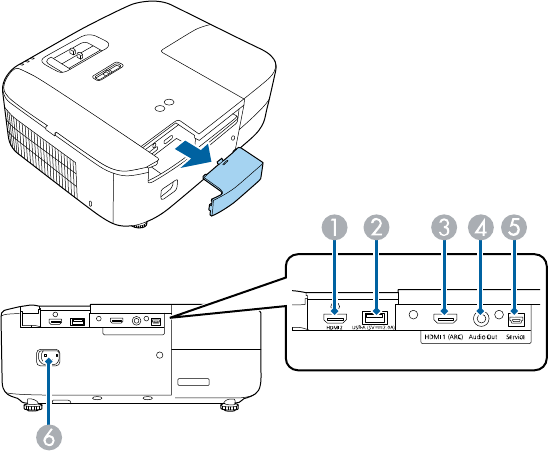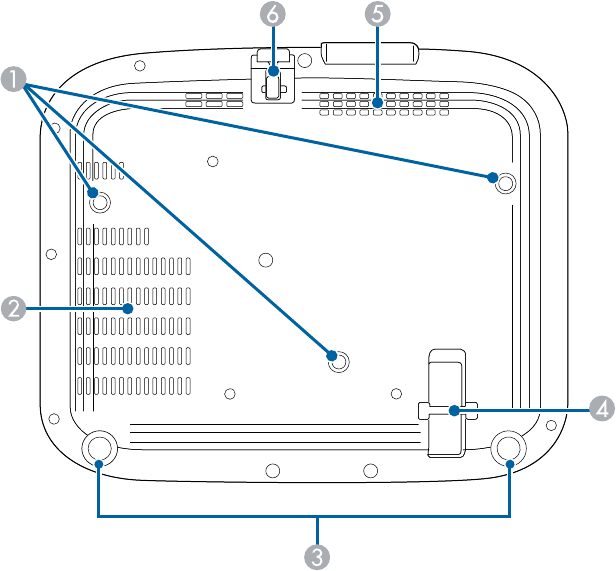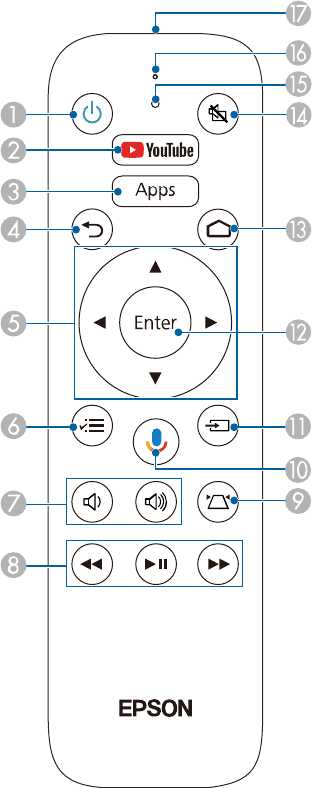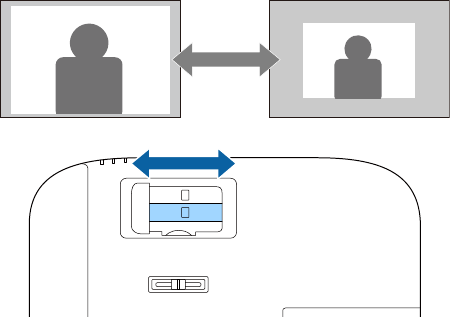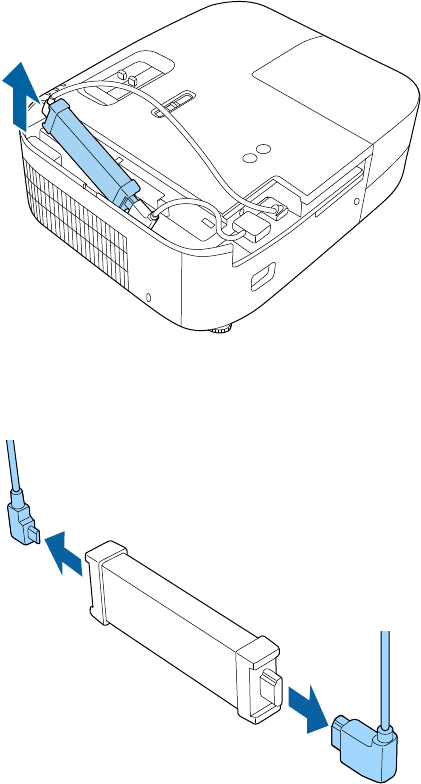
Home Cinema 2350 User's Guide

3
Contents
Home Cinema 2350 User's Guide............................................................................................................... 9
Introduction to Your Projector ................................................................................................................. 10
Projector Features.............................................................................................................................. 10
Product Box Contents.................................................................................................................... 11
Additional Components ................................................................................................................ 11
Optional Equipment and Replacement Parts................................................................................. 12
Warranty and Registration Information (U.S. and Canada) ........................................................... 13
Warranty and Registration Information (Latin America)................................................................. 13
Notations Used in the Documentation ................................................................................................ 14
Where to Go for Additional Information .............................................................................................. 14
Projector Part Locations ..................................................................................................................... 14
Projector Parts - Front/Top ............................................................................................................ 15
Projector Parts - Rear .................................................................................................................... 16
Projector Parts - Base.................................................................................................................... 17
Projector Parts - Remote Control................................................................................................... 18
Setting Up the Projector ........................................................................................................................... 22
Projector Placement........................................................................................................................... 22
Projector Setup and Installation Options ....................................................................................... 22
Projection Distance........................................................................................................................ 25
Installing the Safety Wire ............................................................................................................... 27
Installing Batteries in the Remote Control .......................................................................................... 27
Projector Connections........................................................................................................................ 29
Connecting to an HDMI Video Source ........................................................................................... 29
Connecting to a Computer for HDMI Video and Audio................................................................... 31
Connecting to External Speakers or Headphones......................................................................... 32
Connecting to External Speakers or an A/V Receiver Using HDMI ARC....................................... 33
Connecting to a Streaming Media Player ........................................................................................... 33
Setting Up Android TV........................................................................................................................ 36
Using Basic Projector Features ............................................................................................................... 38
Turning On the Projector .................................................................................................................... 38
4
Turning Off the Projector .................................................................................................................... 40
Remote Control Operation ................................................................................................................. 41
Pairing the Projector Remote Control................................................................................................. 42
Pairing the Remote Control for Android TV ........................................................................................ 43
Selecting the Language for the Projector Menus................................................................................ 44
Adjusting the Image Height ................................................................................................................ 45
Adjusting the Image Position Using Lens Shift ................................................................................... 46
Image Shape...................................................................................................................................... 49
Correcting Image Shape with the Horizontal Keystone Slider ....................................................... 49
Correcting Image Shape with H/V Keystone.................................................................................. 50
Correcting Image Shape with Quick Corner .................................................................................. 51
Resizing the Image with the Zoom Slider ........................................................................................... 54
Focusing the Image Using the Focus Slider ....................................................................................... 55
Selecting an Image Source ................................................................................................................ 55
Projection Modes ............................................................................................................................... 56
Changing the Projection Mode Using the Menus........................................................................... 56
Image Aspect Ratio ............................................................................................................................ 57
Changing the Image Aspect Ratio ................................................................................................. 57
Available Image Aspect Ratios ...................................................................................................... 58
Color Mode......................................................................................................................................... 59
Changing the Color Mode.............................................................................................................. 59
Available Color Modes................................................................................................................... 60
Adjusting Picture Quality in Detail ...................................................................................................... 61
Adjusting Gamma............................................................................................................................... 62
Controlling the Volume with the Volume Buttons................................................................................ 64
Changing the Sound Mode................................................................................................................. 64
Available Sound Modes................................................................................................................. 65
Adjusting Projector Features ................................................................................................................... 67
Operating Connected Devices Using the HDMI Link Features........................................................... 67
Shutting Off the Picture and Sound Temporarily ................................................................................ 69
Projector Security Features................................................................................................................ 70
Locking the Projector's Power Button ............................................................................................ 70
Installing a Security Cable ............................................................................................................. 71
5
Adjusting the Color Convergence (Panel Alignment) ......................................................................... 71
Saving Settings to Memory and Using Saved Settings ...................................................................... 75
Adjusting the Menu Settings .................................................................................................................... 78
Using the Projector's Menus............................................................................................................... 78
Using the Displayed Keyboard ........................................................................................................... 79
Available Keyboard Text ............................................................................................................... 80
Image Quality Settings - Image Menu ................................................................................................ 80
Input Signal Settings - Signal Menu.................................................................................................... 83
Projector Feature Settings - Settings Menu........................................................................................ 86
Projector Setup Settings - Extended Menu......................................................................................... 89
Projector Information Display - Info Menu .......................................................................................... 92
Projector Reset Options - Reset Menu ............................................................................................... 93
Maintaining and Transporting the Projector ........................................................................................... 95
Projector Maintenance ....................................................................................................................... 95
Cleaning the Lens.......................................................................................................................... 95
Cleaning the Projector Case.......................................................................................................... 96
Air Filter and Vent Maintenance .................................................................................................... 96
Cleaning the Air Filter and Vents............................................................................................... 97
Replacing the Air Filter.............................................................................................................. 98
Projector Lamp Maintenance....................................................................................................... 100
Replacing the Lamp ................................................................................................................ 100
Resetting the Lamp Timer....................................................................................................... 105
Replacing the Remote Control Batteries ..................................................................................... 106
Removing the Streaming Device...................................................................................................... 107
Transporting the Projector................................................................................................................ 110
Solving Problems .................................................................................................................................... 111
Projection Problem Tips ................................................................................................................... 111
Projector Light Status ....................................................................................................................... 112
Solving Image or Sound Problems ................................................................................................... 114
Solutions When No Image Appears............................................................................................. 114
Solutions When "No Signal" Message Appears........................................................................... 115
Displaying From a PC Laptop ................................................................................................. 116
Displaying From a Mac Laptop ............................................................................................... 116
6
Solutions When "Not Supported" Message Appears ................................................................... 117
Solutions When Only a Partial Image Appears ............................................................................ 117
Solutions When the Image is Not Rectangular ............................................................................ 117
Solutions When the Image Contains Noise or Static ................................................................... 118
Solutions When the Image is Fuzzy or Blurry .............................................................................. 118
Solutions When the Image Brightness or Colors are Incorrect .................................................... 119
Solutions When the Image is Upside Down ................................................................................. 120
Solutions to Sound Problems ...................................................................................................... 120
Solving Projector or Remote Control Operation Problems ............................................................... 121
Solutions to Projector Power or Shut-Off Problems ..................................................................... 121
Solutions to Remote Control Problems........................................................................................ 122
Solutions to HDMI Link Problems..................................................................................................... 123
Where to Get Help (U.S. and Canada) ............................................................................................. 123
Where to Get Help (Latin America)................................................................................................... 124
Technical Specifications ........................................................................................................................ 127
General Projector Specifications...................................................................................................... 127
Projector Lamp Specifications.......................................................................................................... 129
Remote Control Specifications ......................................................................................................... 129
Bluetooth Specifications................................................................................................................... 130
Projector Dimension Specifications.................................................................................................. 130
Projector Electrical Specifications .................................................................................................... 130
Projector Environmental Specifications............................................................................................ 131
Projector Safety and Approvals Specifications................................................................................. 131
Supported Video Display Formats.................................................................................................... 132
Notices ..................................................................................................................................................... 134
Recycling (U.S. and Canada)........................................................................................................... 134
Important Safety Information ............................................................................................................ 134
Important Safety Instructions............................................................................................................ 135
Restriction of Use ........................................................................................................................ 140
Warning Labels ................................................................................................................................ 140
List of Safety Symbols and Instructions............................................................................................ 141
FCC Compliance Statement............................................................................................................. 145
Binding Arbitration and Class Waiver ............................................................................................... 146
7
Trademarks...................................................................................................................................... 149
Copyright Notice............................................................................................................................... 150
A Note Concerning Responsible Use of Copyrighted Materials ................................................... 151
Copyright Attribution.................................................................................................................... 151

9
Home Cinema 2350 User's Guide
Welcome to the Home Cinema 2350 User's Guide.
For a printable PDF copy of this guide, click here.

10
Introduction to Your Projector
Refer to these sections to learn more about your projector and this manual.
Projector Features
Notations Used in the Documentation
Where to Go for Additional Information
Projector Part Locations
Projector Features
Your projector includes these special features:
Gaming performance
• Dual HDMI ports
• Smooth gaming up to 60 frames per second with 4K Enhancement
Bright, high-resolution projection system
• Up to 2800 lumens of color brightness (color light output) and white brightness (white light output)
Note: Color brightness (color light output) and white brightness (white light output) will vary depending
on usage conditions. Color light output measured in accordance with IDMS 15.4; white light output
measured in accordance with ISO 21118.
• Full HD native resolution with 4K Enhancement for exceptional brightness, color, and detail
• Images up to 500 inches (12.7 m); for projection on any wall or screen
Flexible connectivity
• Built-in Android TV streaming device, preloaded with popular streaming apps
• Control the projector and streaming device with one remote control
• Audio Out port for connection to external speakers or stereo system
Easy-to-use setup and operation features
• Vertical lens shift, automatic vertical keystone correction, and horizontal keystone correction slider for
flexible projector placement
• Epson's Instant Off and Direct Power On features for quick setup and shut down
• 1-1.62 optical zoom ratio

11
Product Box Contents
Additional Components
Optional Equipment and Replacement Parts
Warranty and Registration Information (U.S. and Canada)
Warranty and Registration Information (Latin America)
Parent topic: Introduction to Your Projector
Product Box Contents
Save all the packaging in case you need to ship the projector. Always use the original packaging (or
equivalent) when shipping.
Make sure your projector box included all of these parts:
1 Projector
2 Projector remote control (two AAA batteries)
3 Android TV remote control (two AAA batteries)
4 Alternate rear cover
5 Power cord
Parent topic: Projector Features
Additional Components
Depending on how you plan to use the projector, you may need to obtain additional components.

12
Note: To connect a Mac that does not include a compatible video output port, you need to obtain an
adapter that allows you to connect to an input port on the projector. Contact Apple for compatible
adapter options. To connect a smartphone or tablet, you may need to obtain an adapter that allows you
to connect to the projector. This allows you to mirror your smartphone or tablet screens, watch movies,
and more. Contact your device manufacturer for compatible adapter options.
Unless listed as available from Epson in this table, see your local computer or electronics dealer for
purchase information.
Signal or connection
type
Additional component necessary
HDMI Compatible HDMI cable
Available for purchase from an authorized Epson reseller.
Note: Older Mac computers (2009 and earlier) may not support HDMI
audio.
Parent topic: Projector Features
Optional Equipment and Replacement Parts
U.S. and Canada: You can purchase screens, other optional accessories, and replacement parts from
an Epson authorized reseller. To find the nearest reseller, call 800-GO-EPSON (800-463-7766) in the
U.S. or 800-807-7766 in Canada. Or you can purchase online at epsonstore.com (U.S. sales) or
epsonstore.ca (Canadian sales).
Latin America: You can purchase optional accessories and replacement parts from an Epson
authorized reseller. To find the nearest reseller, go to latin.epson.com. Or you can contact your nearest
sales office as described in "Where to Get Help."
Note: Availability of accessories varies by country.
Epson offers the following optional accessories and replacement parts for your projector:
U.S. and Canada:
Option or part Part number
Genuine Epson replacement lamp (ELPLP97) V13H010L97
Replacement air filter (ELPAF54) V13H134A54
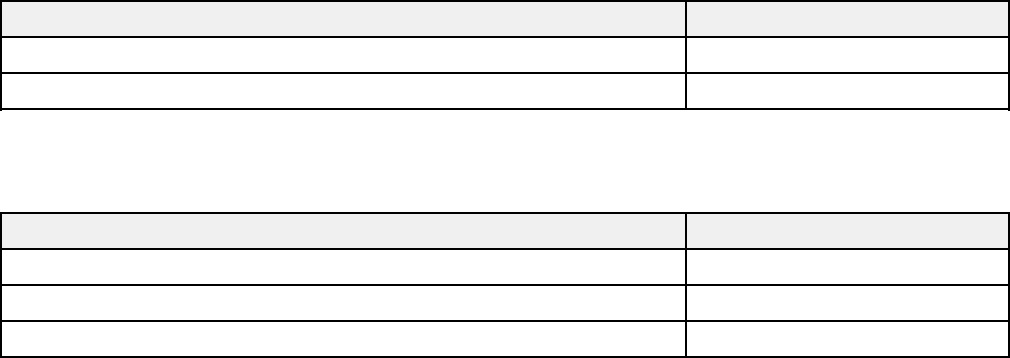
13
Option or part Part number
Universal projector ceiling mount (ELPMBPJG) V12H808001
Safety wire set for ceiling mount (ELPWR01) V12H003W01
In addition to the accessories listed above, extended service plans are available.
Latin America:
Option or part Part number
Genuine Epson replacement lamp (ELPLP97) V13H010L97
Replacement air filter (ELPAF54) V13H134A54
Safety wire set for ceiling mount (ELPWR01) V12H003W01
Parent topic: Projector Features
Related references
Where to Get Help (U.S. and Canada)
Where to Get Help (Latin America)
Warranty and Registration Information (U.S. and Canada)
Your projector comes with a basic warranty that lets you project with confidence. For details, see the
warranty that came with your projector.
Register your product online at this site: epson.com/webreg
Registering also lets you receive special updates on new accessories, products, and services.
Parent topic: Projector Features
Warranty and Registration Information (Latin America)
Your projector comes with a basic warranty that lets you project with confidence. For details, see the
warranty that came with your projector.
Register your product online at latin.epson.com/support, search for your product, and select Register.
Registering also lets you receive special updates on new accessories, products, and services.
Parent topic: Projector Features
14
Notations Used in the Documentation
Follow the guidelines in these notations as you read your documentation:
• Warnings must be followed carefully to avoid bodily injury.
• Cautions must be observed to avoid damage to your equipment.
• Notes contain important information about your projector.
• Tips contain additional projection information.
Parent topic: Introduction to Your Projector
Where to Go for Additional Information
Need quick help on using your projector? Here's where to look for help:
• https://support.google.com/androidtv/ for Android TV support
• epson.com/support (U.S.), epson.ca/support (Canada), or latin.epson.com/support (Caribbean)
View FAQs (frequently asked questions) and e-mail your questions to Epson technical support 24
hours a day.
• If you still need help after checking this manual and any other sources listed here, you can use the
Epson PrivateLine Support service to get help fast (U.S. and Canada only). For details, see "Where to
Get Help."
Parent topic: Introduction to Your Projector
Related references
Where to Get Help (U.S. and Canada)
Where to Get Help (Latin America)
Projector Part Locations
Check the projector part illustrations to learn about the parts on your projector.
Projector Parts - Front/Top
Projector Parts - Rear
Projector Parts - Base
Projector Parts - Remote Control
Parent topic: Introduction to Your Projector
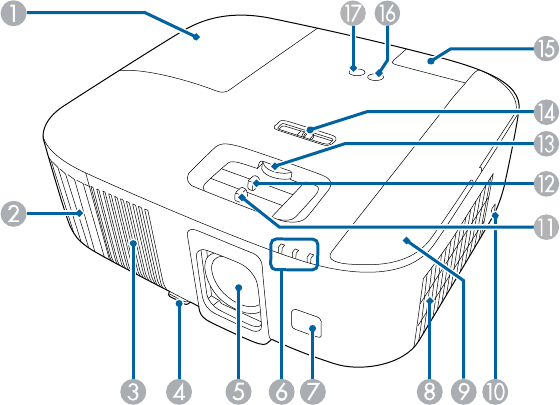
15
Projector Parts - Front/Top
1 Lamp cover
2 Air exhaust vent
3 Speaker
4 Foot release lever
5 Lens
6 Indicators
7 Remote receiver
8 Air intake vent (air filter)
9 Air filter cover
10 Kensington security slot
11 Focus slider
12 Zoom slider
13 Vertical lens shift dial
14 Horizontal keystone slider
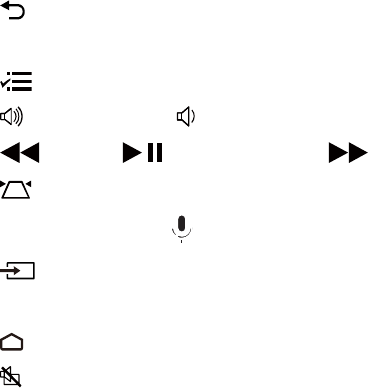
19
1 Power button
2 YouTube button
3 Apps button (displays Android TV streaming apps)
4 return button
5 Arrow buttons (move through on-screen options)
6 menu button
7
volume up and volume down buttons
8
rewind, play/pause, and fast forward buttons (control connected streaming device)
9 keystone button (corrects image distortion)
10
Google Assistant mic button (operates Android TV using voice commands)
11 source button
12 Enter button (selects options)
13 home button (displays the Android TV home screen)
14
A/V mute button (turns off picture and sound)
15 Indicator
16 Microphone
17 Remote control emitter
Note: This remote control is used to control the projector and the connected streaming device after it has
been paired to the projector.
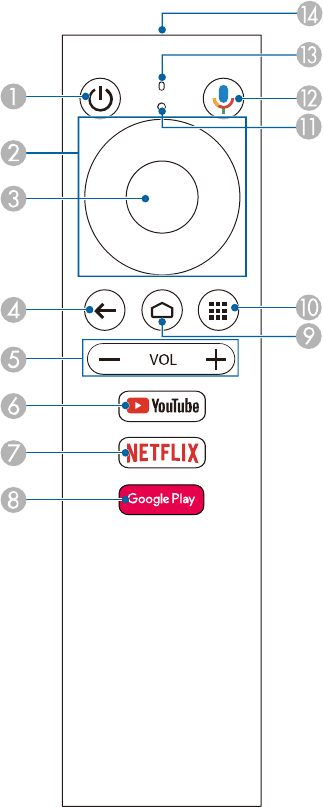
20
Android TV remote control
1 Power button
2 Directional pad

21
3 Enter button
4 Back button
5 Volume buttons
6 YouTube button
7 Netflix button
8 Google Play button
9 Home button (displays the Android TV home screen)
10 Installed apps button
11 Command indicator
12
Google Assistant mic button (operates Android TV using voice commands)
13 Microphone
14 Remote control emitter
Note: This remote control is used to control the streaming device only if it is connected to a different
device or projector. You do not need to use this remote control in addition to the projector remote control.
Parent topic: Projector Part Locations
Related tasks
Using the Projector's Menus
Pairing the Projector Remote Control

22
Setting Up the Projector
Follow the instructions in these sections to set up your projector for use.
Projector Placement
Installing Batteries in the Remote Control
Projector Connections
Connecting to a Streaming Media Player
Setting Up Android TV
Projector Placement
You can place the projector on almost any flat surface to project an image.
You can also install the projector in a ceiling mount if you want to use it in a fixed location.
Keep these considerations in mind as you select a projector location:
• Place the projector on a sturdy, level surface or install it using a compatible mount.
• Place the projector parallel to the screen.
• Leave plenty of space around and under the projector for ventilation, and do not place it on top of or
next to anything that could block the vents.
• Position the projector within reach of a grounded electrical outlet or extension cord.
Projector Setup and Installation Options
Projection Distance
Installing the Safety Wire
Parent topic: Setting Up the Projector
Projector Setup and Installation Options
You can set up or install your projector in the following ways:

23
Front
Rear
Front Ceiling

24
Rear Ceiling
Wherever you set up the projector, make sure to position it squarely in front of the center of the screen,
not at an angle, if possible. If the projector cannot be centered in front of the screen, use lens shift to
reposition the image instead of using keystone correction for better image quality.
If you project from the ceiling or from the rear, be sure to select the correct Projection option in the
projector's menu system.
Installation space
Be sure to leave the following amount of space around the projector so as to not block the air exhaust or
intake vents.
1 3.94 inches (10 cm)
2 7.87 inches (20 cm)
3 11.81 inches (30 cm)
Parent topic: Projector Placement
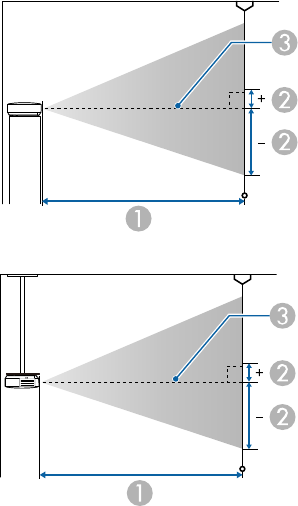
25
Related references
Projector Setup Settings - Extended Menu
Projection Distance
The distance at which you place the projector from the screen determines the approximate size of the
image. The image size increases the farther the projector is from the screen, but can vary depending on
the zoom factor, aspect ratio, and other settings.
Use the table here to determine approximately how far to place the projector from the screen based on
the size of the projected image. (Conversion figures may have been rounded up or down.)
You can also use the Projection Distance Calculator here (U.S.), here (Canada), or here (Caribbean).
1 Projection distance
2 Distance from the center of the lens to the base of the image
3 Center of lens
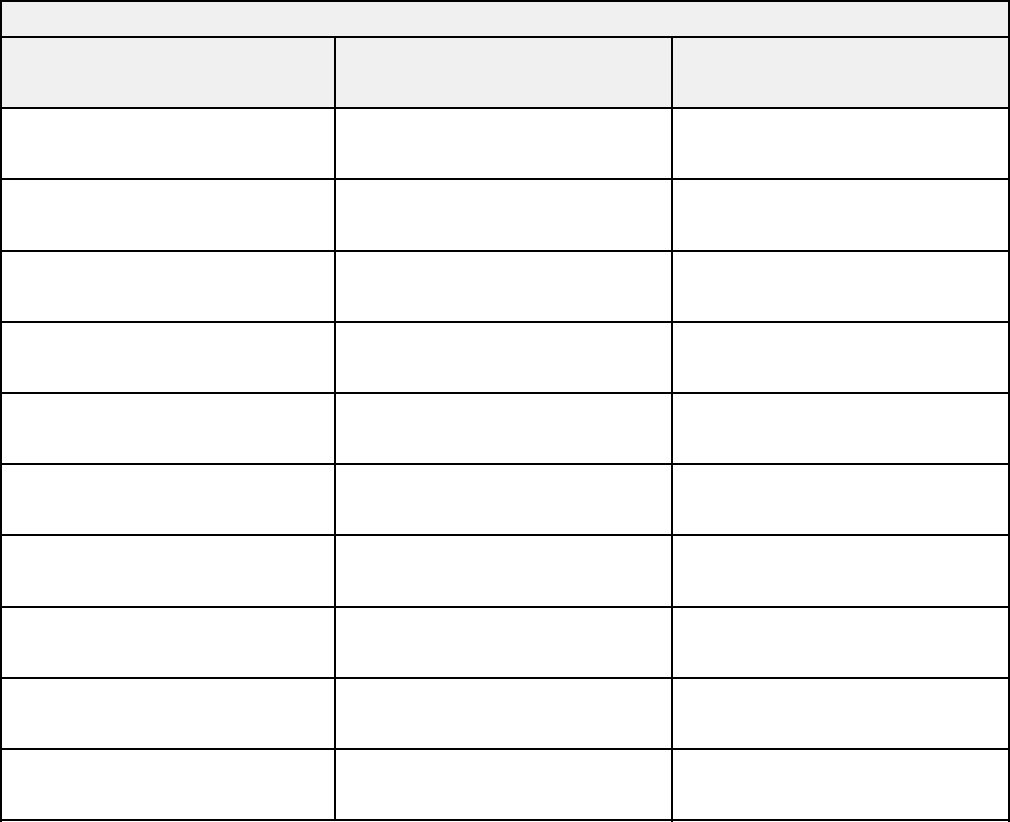
26
16:9 Aspect Ratio Image or Screen
Screen or image size Projection distance (1)
Wide to Tele
Offset from lens center (2)
40 inches 45.3 to 74.4 inches
(115 to 189 cm)
-21.7 to 2.0 inches
(-55 to 5 cm)
60 inches 68.9 to 112.2 inches
(175 to 285 cm)
-32.7 to 3.1 inches
(-83 to 8 cm)
80 inches 92.1 to 150.0 inches
(234 to 381 cm)
-43.3 to 4.3 inches
(-110 to 11 cm)
100 inches 115.7 to 187.8 inches
(294 to 477 cm)
-54.3 to 5.51 inches
(-138 to 14 cm)
120 inches 139.0 to 225.6 inches
(353 to 573 cm)
-65.4 to 6.3 inches
(-166 to 16 cm)
150 inches 174.4 to 282.7 inches
(443 to 718 cm)
-81 to 7.9 inches
(-207 to 20 cm)
200 inches 232.7 to 377.2 inches
(591 to 958 cm)
-108 to 10.6 inches
(-276 to 27 cm)
300 inches 349.6 to 566.5 inches
(888 to 1439 cm)
-163.0 to 16.1 inches
(-414 to 41 cm)
400 inches 466.9 to 755.5 inches
(1186 to 1919 cm)
-217.3 to 21.3 inches
(-552 to 54 cm)
500 inches 583.9 to 944.9 inches
(1483 to 2400 cm)
-271.7 to 28 inches
(-690 to 68 cm)
Note: For screen sizes above 300″, a high-gain screen and a light-controlled environment may be
required.
Parent topic: Projector Placement
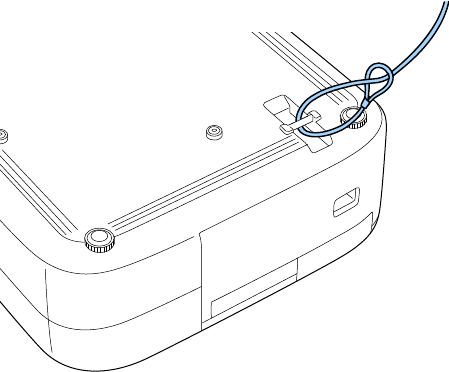
27
Installing the Safety Wire
When installing the projector in a high location such as a ceiling or shelf, you can install the safety wire
(not included) to prevent the projector from falling.
1. Pass the safety wire through the security cable attachment point on the projector.
2. Attach the other end of the safety wire to a structure that is strong enough to bear the projector's
weight. If the wire is too long, loop the wire around so that there is as little slack as possible.
Parent topic: Projector Placement
Related references
Optional Equipment and Replacement Parts
Installing Batteries in the Remote Control
The remote control uses the two AAA batteries that came with the projector.
Note: Make sure you read the safety instructions in this manual before handling the batteries.
Caution: Use only the type of batteries specified in this manual. Do not install batteries of different types,
or mix new and old batteries.

28
1. Remove the battery cover.
2. Insert the batteries with the + and – ends facing as shown.
Warning: Make sure the batteries are inserted in the correct positions. If the batteries are not
inserted correctly, they could explode or leak, causing a fire, injury, or damage to the product.
3. Replace the battery cover and press it down until it clicks into place.
29
Warning: Dispose of used batteries according to local regulations. Do not expose batteries to heat
or flame. Keep batteries out of the reach of children; they are choking hazards and are very
dangerous if swallowed.
Parent topic: Setting Up the Projector
Related references
Important Safety Instructions
Projector Connections
See these sections to connect the projector to a variety of projection sources.
Caution: If you will use the projector at altitudes above 4921 feet (1500 m), turn on High Altitude Mode
to ensure the projector's internal temperature is regulated properly.
Caution: Check the shape and orientation of the connectors on any cable you plan to connect. Do not
force a connector into a port if it does not fit. The device or your projector could be damaged or could
malfunction.
Caution: Make sure you connect the projector and video sources first, and then connect the power cord
to the projector's power inlet and plug it into an electrical outlet.
Connecting to an HDMI Video Source
Connecting to a Computer for HDMI Video and Audio
Connecting to External Speakers or Headphones
Connecting to External Speakers or an A/V Receiver Using HDMI ARC
Parent topic: Setting Up the Projector
Related references
Optional Equipment and Replacement Parts
Projector Parts - Rear
Projector Setup Settings - Extended Menu
Connecting to an HDMI Video Source
If your video source has an HDMI port, you can connect it to the projector using an optional HDMI cable.
The HDMI connection provides the best image quality.

30
Caution: Do not turn on the video source before connecting it to the projector. Doing so could damage
the projector.
Note: When projecting images with 4K Enhancement at 60Hz, use an HDMI 2.1 rated cable (ultra-high
speed). If you use an incompatible cable, images may not be displayed correctly. You can try correcting
the images by changing the EDID setting in the projector's Signal menu.
1. Connect the HDMI cable to your video source's HDMI output port.
2. Connect the other end to the projector's HDMI port.
Note: The projector converts the digital audio signal sent from your video source into a mono analog
signal for the internal speaker or a stereo analog signal if you are connecting to external speakers.
Note: If you connected a game console, it may take a few seconds for your image to appear when you
switch to the game console's input source. To reduce the potential lag in response time to game
commands, set your game console's output format to a progressive signal of 480p, 720p, or higher. See
your game console documentation for instructions.
You can also select the Fast Image Processing setting to reduce lag time.
Note: When an audio/video source that meets the HDMI CEC standard is connected to the projector's
HDMI port, you can use the projector's remote control to control certain features of the linked device by
turning on the HDMI Link setting in the Settings menu.
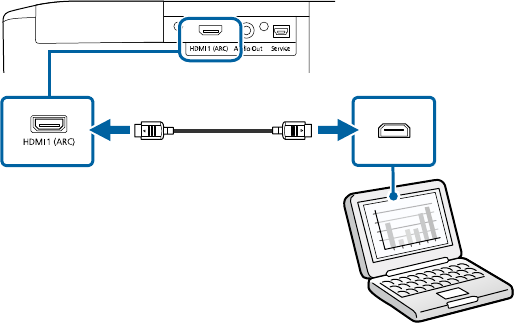
31
Note: If you have problems hearing audio through the HDMI connection, make sure the Audio Out
Device setting in the Settings menu is set correctly.
Parent topic: Projector Connections
Related references
Projector Feature Settings - Settings Menu
Connecting to a Computer for HDMI Video and Audio
If your computer has an HDMI port, you can connect it to the projector using an optional HDMI cable.
Note: To connect a Mac that does not include a compatible video output port, you need to obtain an
adapter that allows you to connect to an input port on the projector. Contact Apple for compatible
adapter options. To connect a smartphone or tablet, you may need to obtain an adapter that allows you
to connect to the projector. This allows you to mirror your smartphone or tablet screens, watch movies,
and more. Contact your device manufacturer for compatible adapter options.
1. Connect the HDMI cable to your computer's HDMI output port.
2. Connect the other end to the projector's HDMI port.
Note: The projector converts the digital audio signal sent from your computer into a mono analog signal
for the internal speaker or a stereo analog signal if you are connecting to external speakers. (Make sure
the HDMI audio playback device on your computer's audio settings is set to EPSON PJ.)
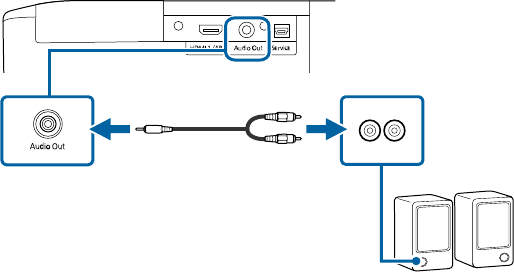
32
Note: If you have problems hearing audio through the HDMI connection, make sure the Audio Out
Device setting in the Settings menu is set correctly.
Parent topic: Projector Connections
Connecting to External Speakers or Headphones
To enhance the sound from your presentation, you can connect the projector to external self-powered
speakers or headphones. You can control the volume using the projector's remote control.
You can also connect the projector to an amplifier with speakers.
Set the HDMI Link setting to On and the Audio Out Device setting to AV System in the projector's
Settings menu. When an audio/video system is not connected to the projector, audio is output from the
external speakers even if Audio Out Device is set to AV System.
Note: The projector's built-in speaker system is disabled when you connect external speakers.
1. Make sure your computer or video source is connected to the projector with both audio and video
cables as necessary.
2. Locate the appropriate cable to connect your external speakers, such as a stereo mini-jack-to-pin-
jack cable, or another type of cable or adapter.
3. Connect one end of the cable to your external speakers as necessary.
4. Connect the stereo mini-jack end of the cable to your projector's Audio Out port.
Parent topic: Projector Connections

33
Connecting to External Speakers or an A/V Receiver Using HDMI ARC
If your external speakers or A/V receiver are HDMI ARC-compatible, you can connect them to the
projector's HDMI1 (ARC) port using an optional HDMI cable. Set the HDMI Link setting to On and the
Audio Out Device setting to AV System in the projector's Settings menu.
1. Connect the HDMI cable to the ARC-compatible HDMI port on your external speakers or A/V
receiver.
2. Connect the other end to the HDMI1 (ARC) port on the projector.
Parent topic: Projector Connections
Related references
Projector Feature Settings - Settings Menu
Connecting to a Streaming Media Player
The projector contains a built-in streaming device, but you can connect a different streaming media
player if necessary. By connecting the streaming media player's power supply USB cable, you can
power the streaming media player from the projector.

34
1. Remove the rear cover.
2. Connect the streaming media player to the projector's HDMI2 port.

35
3. If necessary, connect the streaming media player's power supply USB cable to the USB-A port.
Connect the other end of the cable to the USB port on the streaming media player.
Note: To keep supplying power to the optional streaming media player when the projector is not
projecting images, select Always On as the USB Power setting in the projector's Extended menu.
4. Attach the alternate rear cover.
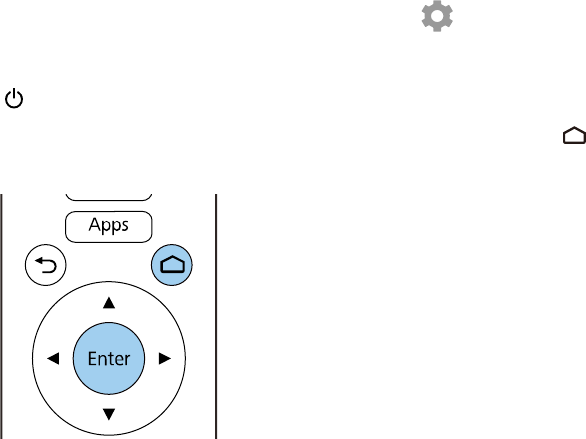
36
Parent topic: Setting Up the Projector
Related references
Projector Setup Settings - Extended Menu
Setting Up Android TV
Android TV must be set up when you turn on the projector for the first time.
Note: A Google account is required to use certain features. Some apps require a paid subscription. After
initial setup, you can change the settings by selecting the icon at the top right of the Android TV
Home screen.
1. Press the power button on the projector or remote control.
2. When the pairing screen is displayed, press and hold the Enter and Home remote control buttons
at the same time.
The light on the remote control flashes until pairing is complete.
3. Use the remote control arrow and Enter buttons to select the language you want to use from the
language selection screen.
4. Do one of the following:
• Select Continue to use an Android phone to set up the projector's Wi-Fi and Google account
settings. Follow the on-screen instructions and skip to step 7.
• Select Skip to set up the projector's Wi-Fi and Google account settings manually. Go to the next
step.
37
5. Select the wireless network you want to use from the Wi-Fi setting screen and then follow the on-
screen instructions to make any necessary settings.
6. At the Google account sign-in screen, do one of the following:
• Select Sign In to sign-in to your Google account. Follow the on-screen instructions.
• Select Skip to use the projector without signing in to a Google account.
7. Follow the on-screen instructions to proceed with initial setup, selecting settings as desired.
The Home screen is displayed when initial setup is completed.
Parent topic: Setting Up the Projector

38
Using Basic Projector Features
Follow the instructions in these sections to use your projector's basic features.
Turning On the Projector
Turning Off the Projector
Remote Control Operation
Pairing the Projector Remote Control
Pairing the Remote Control for Android TV
Selecting the Language for the Projector Menus
Adjusting the Image Height
Adjusting the Image Position Using Lens Shift
Image Shape
Resizing the Image with the Zoom Slider
Focusing the Image Using the Focus Slider
Selecting an Image Source
Projection Modes
Image Aspect Ratio
Color Mode
Adjusting Picture Quality in Detail
Adjusting Gamma
Controlling the Volume with the Volume Buttons
Changing the Sound Mode
Turning On the Projector
Turn on the computer or video equipment you want to use before you turn on the projector so it can
display the image source.
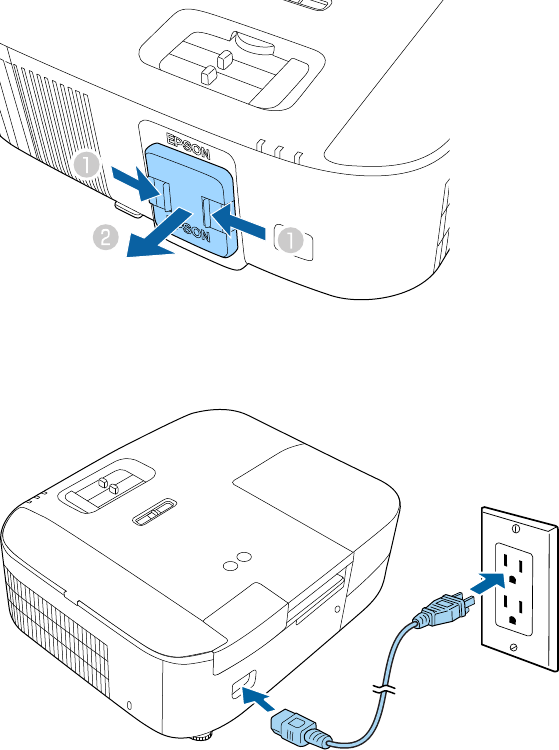
39
1. Remove the projector's lens cover.
2. Connect the power cord to the projector's power inlet.
3. Plug the power cord into an electrical outlet.
Note: With Direct Power On turned on, the projector turns on as soon as you plug it in.
4. Press the power button on the projector or the remote control to turn on the projector.

40
The status light flashes blue as the projector warms up. Once the projector is warmed up, the status
light stops flashing and turns blue.
Warning: Never look into the projector lens when the lamp is on. This can damage your eyes and is
especially dangerous for children.
If you do not see a projected image right away, try the following:
• Turn on the connected computer or video device.
• Insert a DVD or other video media and press the play button, if necessary.
• Change the screen output from the computer when using a laptop.
• Press the source button on the projector or remote control to detect the video source.
Parent topic: Using Basic Projector Features
Turning Off the Projector
Before turning off the projector, shut down any computer connected to it so you can see the computer
display during shutdown.
Note: Turn off this product when not in use to prolong the life of the projector. Lamp life will vary
depending upon mode selected, environmental conditions, and usage. Brightness decreases over time.
1. Press the power button on the projector or remote control.
The projector displays a shutdown confirmation screen.
2. Press the power button again. (To leave it on, press any other button.)
The lamp turns off and the status light turns off.
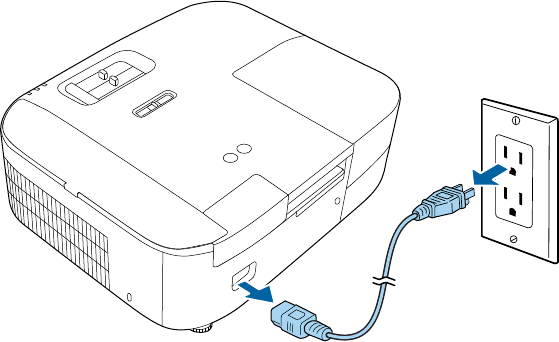
41
Caution: Do not turn the projector on immediately after turning it off. Turning the projector on and off
frequently may shorten the life of the lamp.
Note: To supply power to the streaming media player even when the projector is turned off, select
Always On as the USB Power setting. This shortens the start up time for the streaming media
player and lets it perform automatic updates over a network if necessary.
3. To transport or store the projector, make sure the status light is off, then unplug the power cord.
4. Replace the projector's lens cover.
Parent topic: Using Basic Projector Features
Related references
Projector Setup Settings - Extended Menu
Projector Light Status
Remote Control Operation
The remote control lets you control the projector from almost anywhere in the room. You can point it at
the screen, or the front or back of the projector.
Make sure that you aim the remote control at the projector's receivers within the distance and angles
listed here.
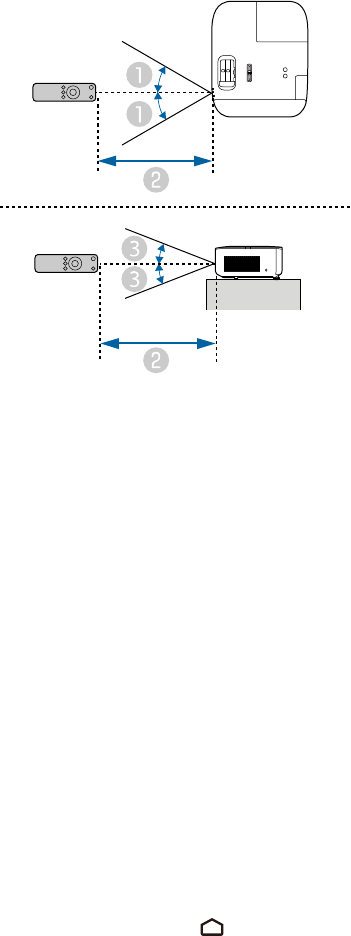
42
1 ± 30°
2 19.7 feet (6 m)
3 ± 15°
Note: Avoid using the remote control in conditions with bright fluorescent lights or in direct sunlight, or
the projector may not respond to commands. If you will not use the remote control for a long time,
remove the batteries.
Parent topic: Using Basic Projector Features
Pairing the Projector Remote Control
To use Android TV and video-on-demand features, you must pair the projector remote control with the
projector.
Note: When you first turn on the projector, instructions for pairing the projector remote control are
displayed on the screen.
1. Turn on the projector.
2. Press and hold the home and Enter buttons on the projector remote control until the command
light on the remote control starts flashing.

43
A message appears on the screen when the projector remote control is paired.
Parent topic: Using Basic Projector Features
Pairing the Remote Control for Android TV
If you connect the projector's built-in streaming device to a different device or projector, you must pair the
remote control for Android TV with the streaming device.
Note: If the streaming device has already been paired, you do not need to pair it again.
1. Turn on the device or projector that the streaming device is connected to.
2. Select the correct input source, if necessary.
3. Press the home button on the projector remote control .
4. Select on the Android TV home screen.
5. Select Remote & accessories.
6. Select Add accessory.
Note: After completing this step, put down the projector remote control and use the Android TV
remote control for the remaining steps.
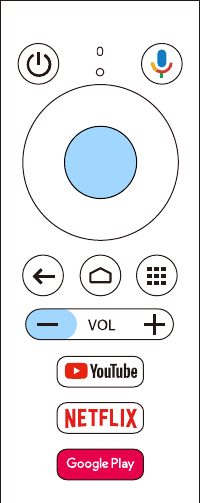
44
7. Press and hold the volume down and enter buttons on the remote control for Android TV until the
command light on the remote control starts flashing.
8. Select EPSON ATV REMOTE on the screen.
The command light stops flashing when the remote control for Android TV is paired.
Parent topic: Using Basic Projector Features
Related references
Projector Parts - Remote Control
Related tasks
Removing the Streaming Device
Selecting the Language for the Projector Menus
If you want to view the projector's menus and messages in another language, you can change the
Language setting.
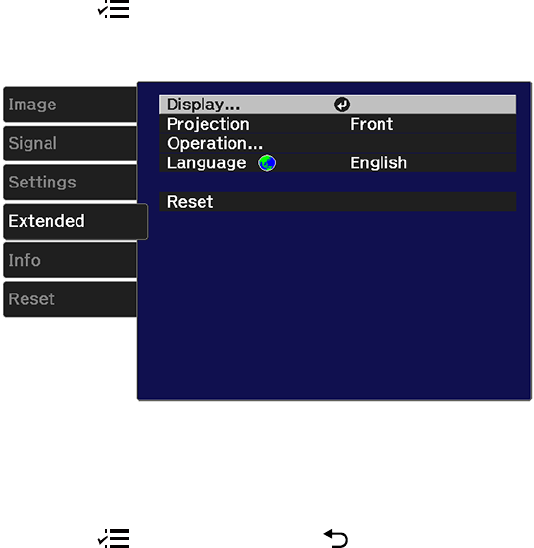
45
1. Turn on the projector.
2. Press the menu button on the projector remote control.
3. Select the Extended menu and press Enter.
4. Select the Language setting and press Enter.
5. Select the language you want to use and press Enter.
6. Press the menu button or the return button to exit the menus.
Parent topic: Using Basic Projector Features
Adjusting the Image Height
If you are projecting from a table or other flat surface, and the image is too high or low, you can adjust
the image height using the projector's adjustable feet.
1. Turn on the projector and display an image.
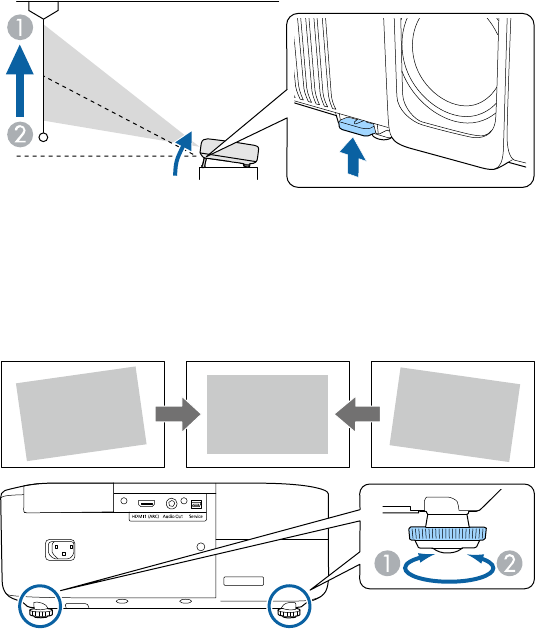
46
2. To adjust the front foot, pull up on the foot release lever and lift the front of the projector.
The foot extends from the projector.
3. Release the lever to lock the foot.
4. If the image is tilted, rotate the rear feet to adjust their height.
If the projected image is unevenly rectangular, you need to adjust the image shape.
Parent topic: Using Basic Projector Features
Related concepts
Image Shape
Adjusting the Image Position Using Lens Shift
If you cannot install the projector directly in front of the screen, you can adjust the position of the
projected image using the vertical lens shift feature.
47
Follow these guidelines when using lens shift to adjust your images:
• When adjusting the image height, position the image lower than where you want it to be and then
move it up using the vertical lens shift dial. This helps prevent the image from moving down after
adjustment.
• Keep the vertical lens shift dial in its center position for the clearest picture.
1. Turn on the projector and display an image.
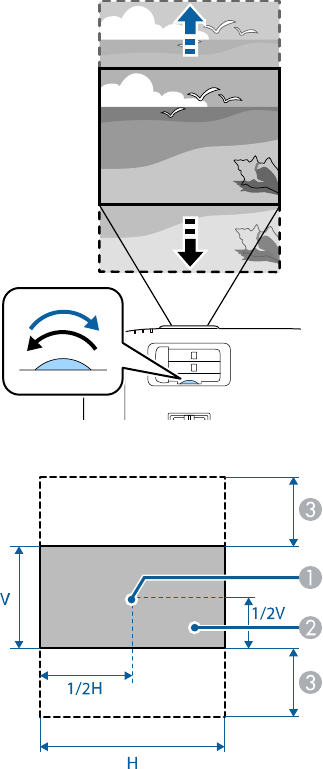
48
2. Turn the vertical lens shift dial on the projector to adjust the position of the projected image as
necessary.
1 Center of lens
2 Projected image when the lens is set to the home position
49
3 Maximum range: V × 60%
Parent topic: Using Basic Projector Features
Image Shape
You can project an evenly rectangular image by placing the projector directly in front of the center of the
screen and keeping it level. If you place the projector at an angle to the screen, or tilted up or down, or off
to the side, you may need to correct the image shape for the best display quality.
When you turn on automatic keystone correction in your projector's Settings menu, your projector
automatically corrects vertical keystone effects when you reposition the projector. This feature can
correct the image up to 30° up or down.
After correction, your image is slightly smaller.
Correcting Image Shape with the Horizontal Keystone Slider
Correcting Image Shape with H/V Keystone
Correcting Image Shape with Quick Corner
Parent topic: Using Basic Projector Features
Related references
Projector Feature Settings - Settings Menu
Correcting Image Shape with the Horizontal Keystone Slider
You can use the projector's horizontal keystone slider to correct the shape of an image that is unevenly
rectangular horizontally, such as when the projector is placed to the side of the projection area.
You can make effective corrections when the projection angle is about 30º right or left.
Note: To provide the best possible image quality, adjust the projector's position to correct the image
shape. If this isn't possible, use the horizontal keystone slider on the projector to correct the image
shape.
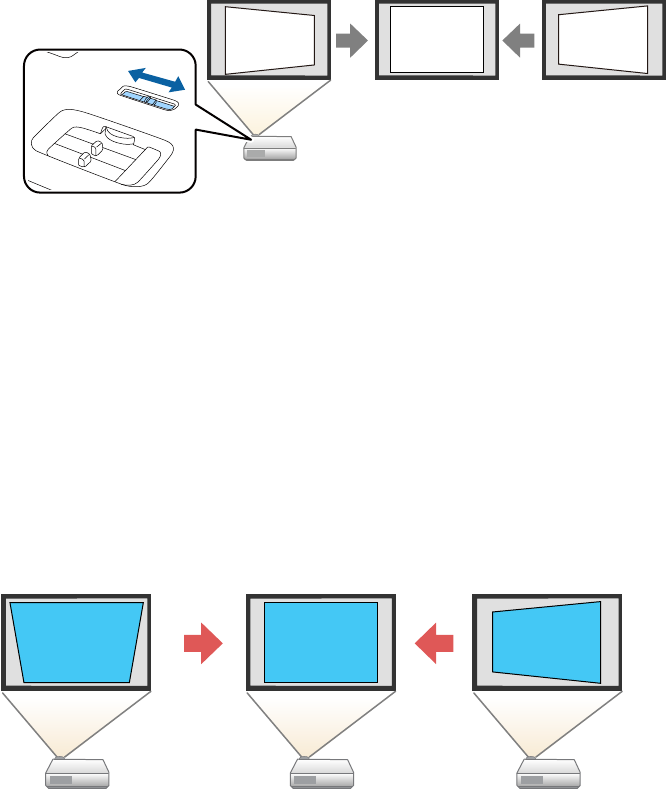
50
1. Turn on the projector and display an image.
2. Adjust the slider until the image is evenly rectangular.
After correction, your image is slightly smaller.
Parent topic: Image Shape
Correcting Image Shape with H/V Keystone
You can use the projector remote control to correct the shape of an image that is unevenly rectangular
on the sides.
Note: To provide the best possible image quality, adjust the projector's position to correct the image
shape. If this isn't possible, use the keystone correction settings to correct the image shape.
Note: You can also adjust the keystone settings from the Settings > Keystone > H/V Keystone menu.
Note: You cannot combine Keystone correction with other image shape correction methods.
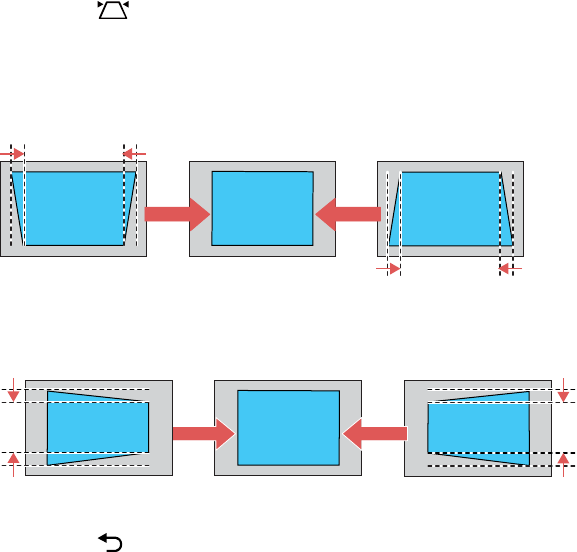
51
1. Turn on the projector and display an image.
2. Press the keystone button on the projector remote control.
3. Use the arrow buttons on the projector remote control to select between vertical and horizontal
keystone correction, and to adjust the image shape as necessary.
V-Keystone
H-Keystone
4. Press the return button when you are finished.
After correction, your image is slightly smaller.
Parent topic: Image Shape
Related references
Projector Feature Settings - Settings Menu
Correcting Image Shape with Quick Corner
You can use the projector's Quick Corner setting to correct the shape and size of an image that is
unevenly rectangular on all sides.
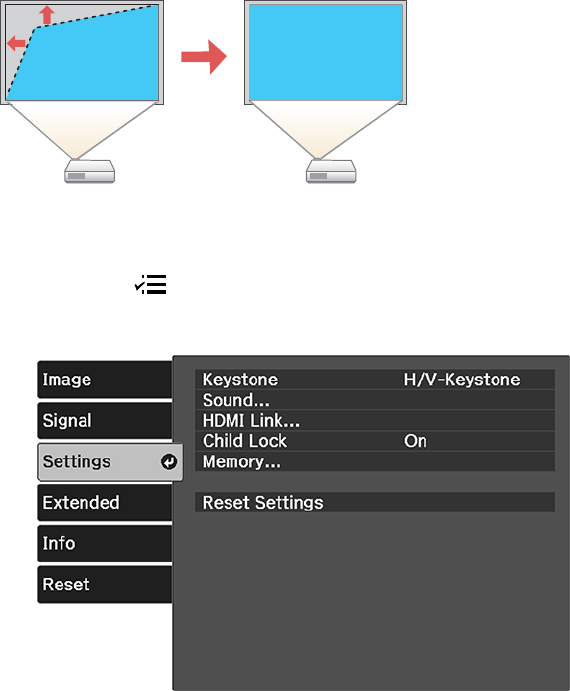
52
Note: To provide the best possible image quality, adjust the projector's position to correct the image
shape. If this isn't possible, use the Quick Corner setting to correct the image shape.
1. Turn on the projector and display an image.
2. Press the menu button on the projector remote control.
3. Select the Settings menu and press Enter.
4. Select the Keystone setting and press Enter.
5. Select the Quick Corner setting and press Enter. Then press Enter again.

53
You see the Quick Corner adjustment screen:
6. Use the arrow buttons on the remote control to select the corner of the image you want to adjust.
Then press Enter.
Note: To reset your adjustments, press and hold the return button for at least 2 seconds to
display a reset screen. Then select Yes.
7. Press the arrow buttons to adjust the image shape as necessary. Press Enter to return to the area
selection screen.
Note: If one of the directional arrows on the screen turns gray, you cannot adjust the shape any
further in that direction.
8. When you are finished, press the return button.
After correction, your image is slightly smaller.
Note: The Keystone setting controls the action of the keystone button on the projector remote
control. The next time you press the button, the Quick Corner adjustment screen will open.
Parent topic: Image Shape
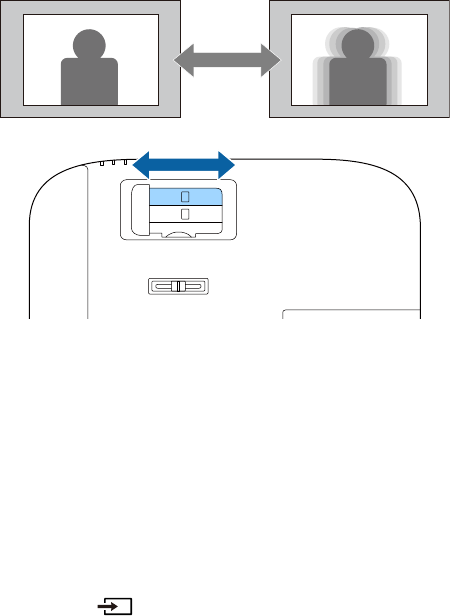
55
Focusing the Image Using the Focus Slider
1. Turn on the projector and display an image.
2. To sharpen the image focus, adjust the focus slider.
Parent topic: Using Basic Projector Features
Selecting an Image Source
If you connected an additional image source to the projector, such as a computer or DVD player, you
may want to switch from one image source to the other.
1. Make sure the connected image source you want to use is turned on.
2. For video image sources, insert a DVD or other video media and press its play button, if necessary.
3. Press the source button on the projector or remote control. Press the up or down buttons to
select the image source.
Note: If no image signal is detected, check the cable connections between the projector and the
image source.
Parent topic: Using Basic Projector Features
Related concepts
Projector Connections

56
Projection Modes
Depending on how you positioned the projector, you may need to change the projection mode so your
images project correctly.
• Front (default setting) lets you project from a table in front of the screen.
• Front/Ceiling flips the image over top-to-bottom to project upside-down from a ceiling or wall mount.
• Rear flips the image horizontally to project from behind a translucent screen.
• Rear/Ceiling flips the image over top-to-bottom and horizontally to project from the ceiling and behind
a translucent screen.
Changing the Projection Mode Using the Menus
Parent topic: Using Basic Projector Features
Changing the Projection Mode Using the Menus
You can change the projection mode to flip the image over top-to-bottom and/or left-to-right using the
projector menus.
1. Turn on the projector and display an image.
2. Press the menu button.
3. Select the Extended menu and press Enter.
4. Select the Projection setting and press Enter.

57
5. Select a projection mode and press Enter.
6. Press the menu button or the return button to exit the menus.
Parent topic: Projection Modes
Image Aspect Ratio
The projector can display images in different width-to-height ratios called aspect ratios. Normally the
input signal from your video source determines the image's aspect ratio. However, for certain images
you can change the aspect ratio to fit your screen by pressing a button on the remote control.
If you always want to use a particular aspect ratio for a certain video input source, you can select it using
the projector's menus.
Changing the Image Aspect Ratio
Available Image Aspect Ratios
Parent topic: Using Basic Projector Features
Changing the Image Aspect Ratio
You can change the aspect ratio of the displayed image to resize it.
Note: For HDMI sources, the input signal determines the image's aspect ratio.
1. Turn on the projector and switch to the image source you want to use.
2. Press the menu button on the projector remote control.
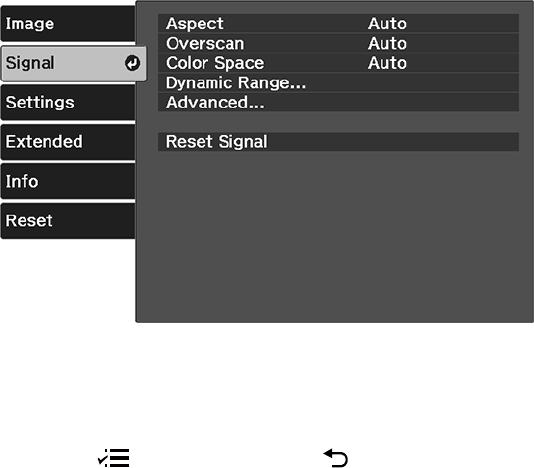
58
3. Select the Signal menu and press Enter.
4. Select Aspect and press Enter.
5. Select the aspect ratio you want to use for your input signal and press Enter.
6. Press the menu button or the return button to exit the menus.
Parent topic: Image Aspect Ratio
Related references
Available Image Aspect Ratios
Input Signal Settings - Signal Menu
Available Image Aspect Ratios
You can select the following image aspect ratios, depending on the input signal from your image source.
Note: When the projector is projecting in Full HD resolution via an HDMI connection, the aspect ratio is
automatically set to Normal.
Note: Using the aspect ratio function to reduce, enlarge, or split the projected image for commercial
purposes or for public viewing may infringe upon the rights of copyright holder of that image based on
copyright law.
Note: Black bands and cropped images may project in certain aspect ratios, depending on the aspect
ratio and resolution of your input signal.

59
Aspect ratio setting Description
Auto Automatically sets the aspect ratio according to the input signal.
Normal Displays images using the full projection area and maintains the
aspect ratio of the image.
Zoom Displays images using the full width of the projection area and
maintains the aspect ratio of the image.
Full Displays images using the full width of the projection area, but does
not maintain the aspect ratio.
Parent topic: Image Aspect Ratio
Color Mode
The projector offers different Color Modes to provide optimum brightness, contrast, and color for a
variety of viewing environments and image types. You can select a mode designed to match your image
and environment, or experiment with the available modes.
If you always want to use a particular color mode for a certain video input source, you can select it using
the projector menus.
Changing the Color Mode
Available Color Modes
Parent topic: Using Basic Projector Features
Changing the Color Mode
You can change the projector's Color Mode to optimize the image for your viewing environment.
1. Turn on the projector and switch to the image source you want to use.
2. If you are projecting from a DVD player or other video source, insert a disc or other video media and
press the play button, if necessary.

60
3. Press the menu button on the projector remote control.
4. Select the Image menu and press Enter.
5. Select Color Mode and press Enter.
6. Press the arrow buttons to select a color mode setting and press Enter.
7. When you are finished, press menu or return.
Parent topic: Color Mode
Available Color Modes
You can set the projector to use these Color Modes, depending on the input source you are using:
Color Mode Description
Dynamic Best for prioritizing brightness
Vivid Best for enjoying content in a bright environment
Cinema Best for movies projected in a dark room with natural tone images
Natural Best for adjusting the image color
Parent topic: Color Mode

61
Adjusting Picture Quality in Detail
You can fine-tune the image details using the projector menus.
1. Turn on the projector and switch to the image source you want to use.
2. Press the menu button on the projector remote control.
3. Select the Image menu and press Enter.
4. Select the Expert Settings setting and press Enter.
5. Adjust the following settings.
• Brightness: Adjusts overall color brightness
• Contrast: Adjusts the difference between light and dark areas of the image
• Color Saturation: Adjusts the overall color density
• Tint: Adjusts the balance of green and magenta in the image
• Sharpness: Adjusts the overall image sharpness
• White Balance: Color Temp sets the color temperature according to the color mode you
selected. Higher values tint the image blue, while lower numbers tint the image red. To adjust
individual RGB offset and gain, select Custom.
• Frame Interpolation: Smooths fast-moving video by comparing consecutive image frames and
inserting an intermediate image frame between them
• Scene Adaptive Gamma: Adjusts the coloring according to the scene to present a more vivid
image. Larger numbers increase contrast.
• Gamma: Adjusts the colors by selecting one of the gamma correction values or referring to a
gamma graph
• RGBCMY: Adjusts the hue, saturation, and brightness for each color
• Auto Iris: Adjusts the projected luminance based on the image brightness
Note: The Brightness setting does not affect lamp brightness. To change the lamp brightness,
adjust the Image > Light Output setting.
6. Select Image Enhancement and adjust the following settings.
• 4K Enhancement: Projects at a doubled resolution
• Image Preset Mode: Selects preset image enhancement settings
• Noise reduction: Reduces flickering in images

62
• MPEG Noise Reduction: Reduces the noise or static in MPEG video
• Detail Enhancement: Enhances details to create clear outlines
Note: Noise Reduction and MPEG Noise Reduction are available when Image Processing is set
to Fine, Image Preset Mode is not set to Off, and the input signal is not 4K or 21:9 (2560 × 1080).
Note: Detail Enhancement is available when Image Preset Mode is not set to Off.
Note: Frame Interpolation is available when Image Processing is set to Fine, Image Preset
Mode is not set to Off, 4K Enhancement is set to Off for input signals other than 1080p 24Hz, and
the input signal is not 4K.
7. Press the return button to exit the menus.
Parent topic: Using Basic Projector Features
Related references
Image Quality Settings - Image Menu
Adjusting Gamma
You can adjust the gamma to improve differences in halftone brightness that vary depending on the
connected device.
Note: Project a still image to adjust the gamma; you cannot adjust it properly when projecting a movie or
other moving video. Medical images may not reproduce correctly depending on your operating
environment and screen.
1. Turn on the projector and switch to the image source you want to use.
2. Press the menu button on the projector remote control.
3. Select the Image menu and press Enter.
4. Select the Expert Settings > Gamma setting and press Enter.
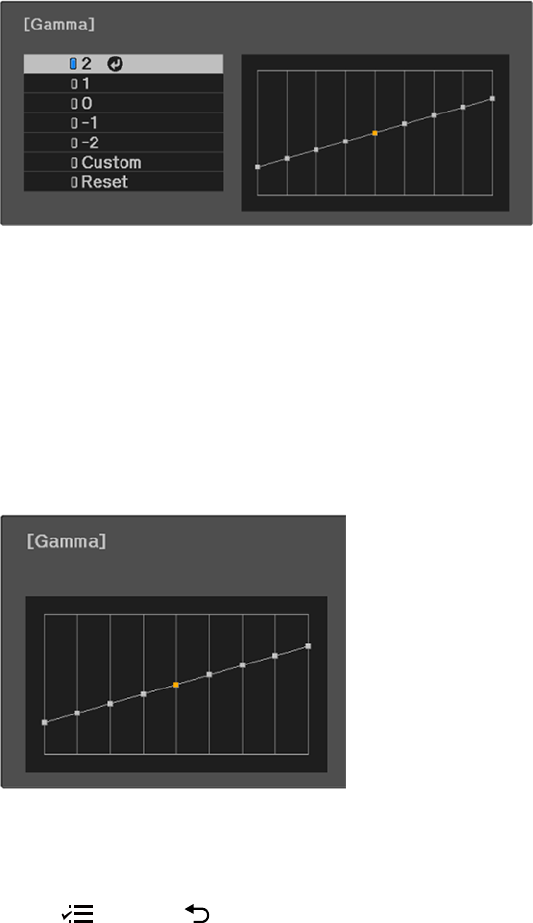
63
You see a screen like this:
5. Select and adjust the correction value.
Note: When you select a smaller value, you can reduce the overall brightness of the image to make
the image sharper. When you select a larger value, the dark areas of images become brighter, but
the color saturation for lighter areas may become weaker.
6. If you want to make finer adjustments, select Custom and press Enter.
You see a screen like this:
7. Press the left or right arrow button to select the tone you want to change, then press the up or down
arrow button to adjust the tone and press Enter.
8. Press menu or return on the projector remote control to exit the menus.

64
Parent topic: Using Basic Projector Features
Related references
Image Quality Settings - Image Menu
Controlling the Volume with the Volume Buttons
You can use the Volume buttons on the remote control to adjust the volume of your projected content.
The volume buttons control the projector’s internal speaker system or any external speakers you
connected to the projector. You can also control the volume for Bluetooth audio devices connected to the
projector.
You must adjust the volume separately for each connected input source.
Warning: Do not start playback at a high volume. Sudden loud noises may cause hearing loss. Always
lower the volume before turning off the projector. Gradually increase the volume after turning the
projector on.
Note: To adjust the volume of a connected audio/video system, set the HDMI Link setting to On and the
Audio Out Device setting to AV System in the projector's Settings menu.
1. Turn on the projector and start a presentation that includes audio.
2. To raise or lower the volume, press the volume up or volume down button on the projector
remote control.
Note: If you lowered the streaming device volume all the way using the Android TV remote control,
you must first raise the volume using the Android TV remote control, and then adjust the volume
using the projector remote control.
Parent topic: Using Basic Projector Features
Related references
Projector Feature Settings - Settings Menu
Changing the Sound Mode
You can change the projector's sound mode to provide optimal sound for a variety of image types.
1. Turn on the projector and start a video.
2. Press the menu button on the projector remote control.
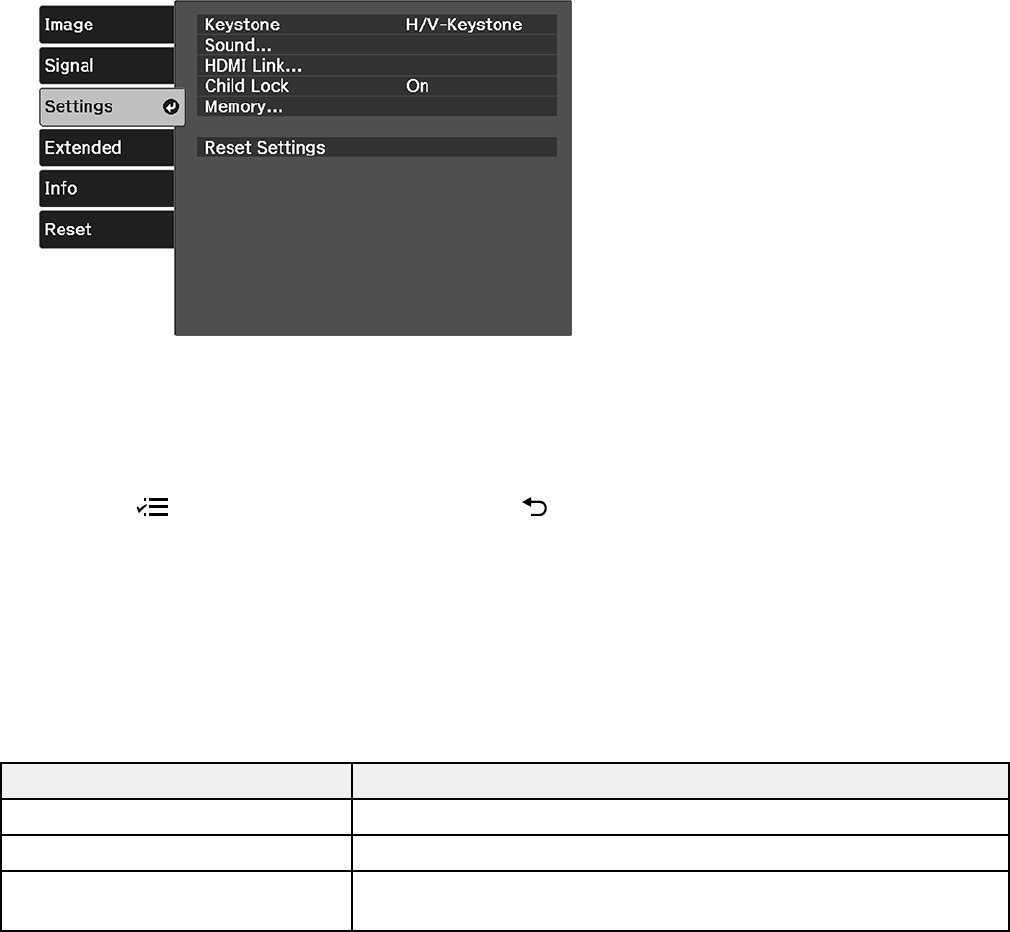
65
3. Press the arrow buttons to select the Settings menu and press Enter.
4. Select the Sound setting and press Enter.
5. Select the Sound Mode setting and press Enter.
6. Select a sound mode and press Enter.
7. Press the menu button to exit the menu or the return button to return to the previous screen.
Available Sound Modes
Parent topic: Using Basic Projector Features
Related references
Projector Feature Settings - Settings Menu
Available Sound Modes
You can set the projector to use these sound modes, depending on the input source you are using:
Sound Mode Description
Standard Outputs audio using normal sound quality
Vocal Best for hearing voices and spoken dialogue
Music Best for listening to music. Higher and lower pitched sounds are
clearer.

67
Adjusting Projector Features
Follow the instructions in these sections to use your projector's feature adjustments.
Operating Connected Devices Using the HDMI Link Features
Shutting Off the Picture and Sound Temporarily
Projector Security Features
Adjusting the Color Convergence (Panel Alignment)
Saving Settings to Memory and Using Saved Settings
Operating Connected Devices Using the HDMI Link Features
You can use the remote control to control certain features of devices connected to the projector's HDMI
ports.
Note: The connected device and HDMI cable must meet the HDMI CEC standard. The device must also
be configured. Some connected devices or functions of those devices may not operate properly even
though they meet the HDMI CEC standard. See the documentation supplied with the device for more
information.
1. Press the menu button on the projector remote control.
2. Select the Settings menu and press Enter.
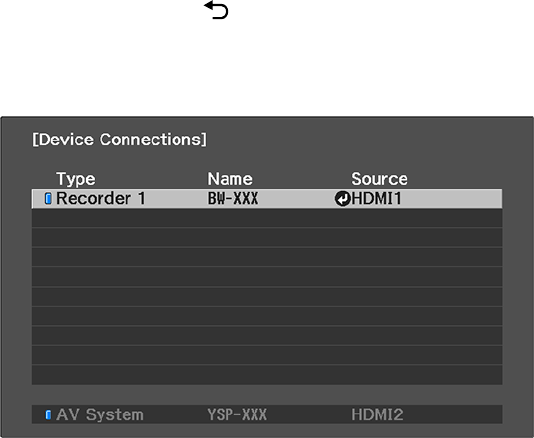
68
3. Select the HDMI Link setting and press Enter.
4. Select HDMI Link and press Enter.
5. Select On and press return button.
6. Select Device Connections and press Enter.
You see a screen like this:
Note: The active linked device source is indicated in blue.
Note: The device name is left blank if it cannot be acquired.
7. Select the device you want to control and project images from and press Enter.
8. Select the following HDMI link options as necessary:
• Audio Out Device: selects which device outputs audio. Select Projector to output audio from the
projector’s built-in speakers or from an external speaker connected to the Audio Out port. Select
AV System to output audio from an AV amplifier that supports the HDMI CEC standards.
• Power On Link: select what happens when you turn on the projector or linked device. Select PJ -
> Device or Bidirectional to turn the linked device on when the projector is turned on, or Device -
> PJ or Bidirectional to turn the projector on when the linked device is turned on.
• Power Off Link: select whether linked devices are turned off when the projector is turned off.

69
Note: Power Off Link only works when the CEC power link function is enabled on the linked
device.
Note: In some cases, the linked device may not be turned off (for example, if it is recording).
When you connect smart speakers to the projector, select the following projector settings for best
results:
• HDMI Link: On
• Power On Link: Bidirectional or Device -> PJ
• Power Off Link: On
• USB Power: Always On
9. When you are finished, press return button.
Parent topic: Adjusting Projector Features
Related references
Projector Setup Settings - Extended Menu
Shutting Off the Picture and Sound Temporarily
You can temporarily turn off the projector's picture and sound. Any sound or video action continues to
run, however, so you cannot resume projection at the point that you stopped it.
1. Press the A/V mute button on the projector remote control to temporarily stop projection and mute
any sound.
2. To turn the picture and sound back on, press the A/V mute button again.
Parent topic: Adjusting Projector Features

70
Projector Security Features
You can secure your projector to deter theft or prevent unintended use by setting up the following
security features:
• Button lock security to block operation of the projector using the power button on the control panel.
• Security cabling to physically cable the projector in place.
Locking the Projector's Power Button
Installing a Security Cable
Parent topic: Adjusting Projector Features
Locking the Projector's Power Button
You can lock the power button on the projector's control panel to prevent a child or anyone from using
the projector.
Note: You can still operate the projector using the projector remote control.
1. Press the menu button on the projector remote control.
2. Select the Settings menu and press Enter.
You see this screen:
3. Select Child Lock and press Enter.
71
4. Select On and press Enter.
5. If you see a confirmation screen, select Yes and press Enter. You must turn the projector off and
then on again to enable the setting.
Note: To turn the projector on when this setting is enabled, you must press and hold the power button for
about 3 seconds.
Note: If the Direct Power On setting is enabled, the projector turns on as soon as you plug it in even
when the Child Lock setting is enabled.
Parent topic: Projector Security Features
Related references
Projector Feature Settings - Settings Menu
Installing a Security Cable
You can install two types of security cables on the projector to deter theft.
• Use the security slot on the projector to attach a Kensington lock. See your local computer or
electronics dealer for purchase information.
• Use the security cable attachment point on the projector to attach a wire cable and secure it to a room
fixture or heavy furniture.
Parent topic: Projector Security Features
Related references
Projector Parts - Base
Adjusting the Color Convergence (Panel Alignment)
You can use the Panel Alignment feature to manually adjust the color convergence (the alignment of the
red and blue colors) in the projected image.
Note: You can adjust only the red or blue color convergence. Green is the standard color panel and
cannot be adjusted.
Note: Allow your projector to warm up for at least 10 to 15 minutes and make sure the image is in focus
before you use the Panel Alignment feature.
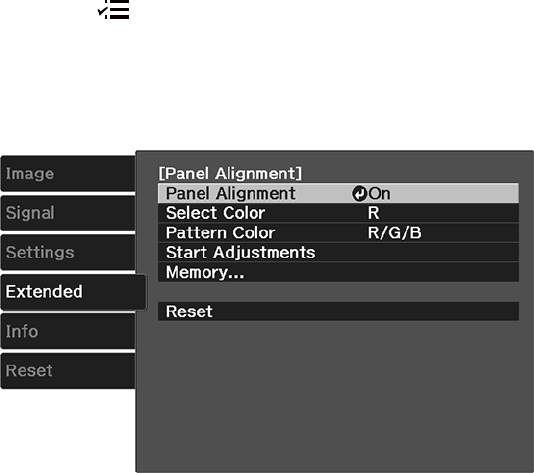
72
Note: For best results, project an image sized at least 60 inches (152 cm) diagonally in a dark room and
on a projection surface that is not colored or textured.
Note: You can adjust the pixels up to ±3 pixels in 0.125 pixel increments.
Note: Image quality may decline after you perform Panel Alignment.
1. Turn on the projector.
2. Press the menu button.
3. Select the Extended menu and press Enter.
4. Select the Display setting and press Enter.
5. Select the Panel Alignment setting and press Enter.
6. Select the Panel Alignment setting and press Enter.
7. Select On and press Enter.
8. Select the Select Color setting and choose one of the following:
• R to adjust the red color convergence.
• B to adjust the blue color convergence.
9. Select the Pattern Color setting and press Enter.
10. Select the pattern you want to use and press Enter.
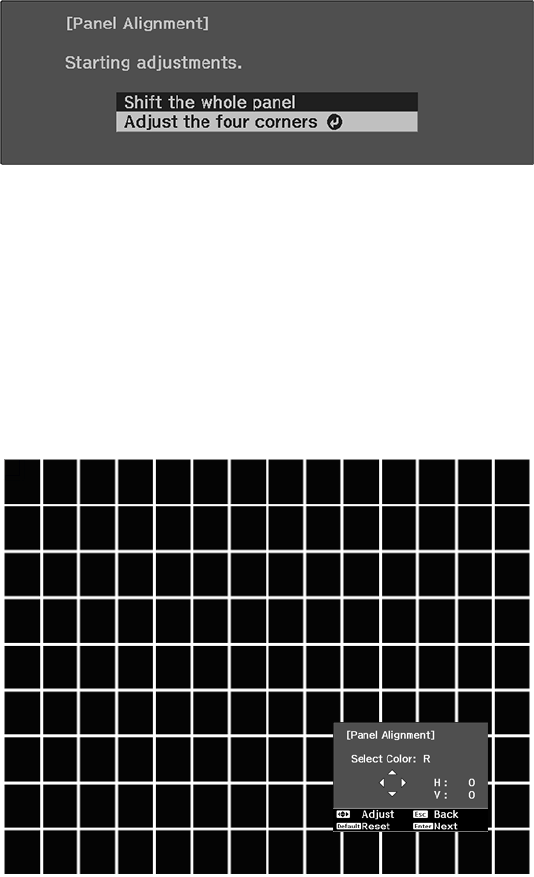
73
11. Select Start Adjustments and press Enter.
You see this screen:
12. Select one of the following:
• Select Shift the whole panel to adjust the whole panel at the same time. (This is not
recommended, as usually only certain areas of the panel need to be adjusted.) Continue with step
13.
• Select Adjust the four corners to adjust the corners of the panel one at a time. Skip to step 16.
13. Press Enter.
You see a screen like this:

74
14. Use the arrow buttons on the remote control to adjust the color alignment of the color you selected
for the Select Color setting.
15. When you are finished adjusting the screen, press Enter.
You see this screen:
Note: The Shift the whole panel option affects the grid lines in the entire screen. To fine-tune your
adjustments, continue with the next steps.
16. Select Adjust the four corners and press Enter. (Otherwise, select Exit and press Enter.)
17. Use the arrow buttons on the remote control to adjust the color alignment in the corner of the screen
highlighted by the orange box.
18. Press the Enter button to move to the next corner of the screen.
19. When you are finished adjusting each corner of the screen, press Enter.
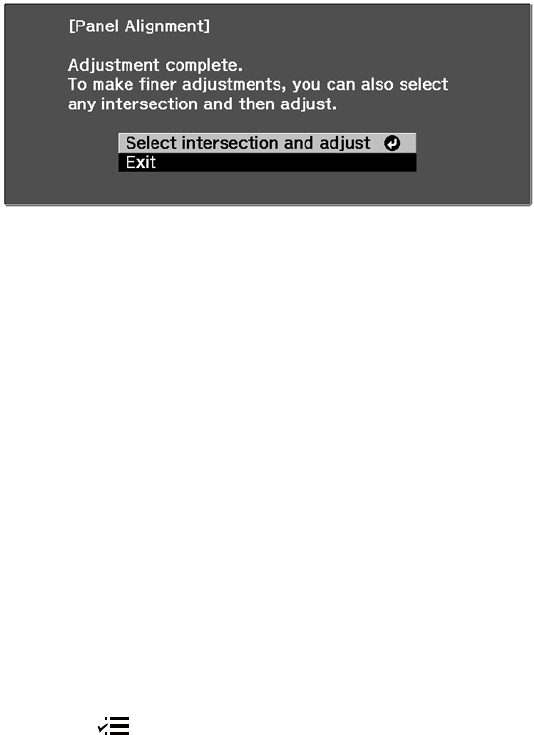
75
You see this screen:
20. Do one of the following:
• If your projector's panel alignment is now correct, select Exit and press Enter to return to the
Panel Alignment menu.
• If your projector needs additional panel alignment, select Select intersection and adjust and
press Enter. Use the arrow keys on the remote control to highlight the corner of any misaligned
box on the screen, press Enter, make any necessary adjustments, and press Enter again. Repeat
this step as necessary for the other intersections.
Parent topic: Adjusting Projector Features
Related references
Projector Setup Settings - Extended Menu
Saving Settings to Memory and Using Saved Settings
You can save customized settings from the Image menu for each of your video inputs and then select
the saved settings whenever you want to use them.
1. Turn on the projector and display an image.
2. Press the menu button.
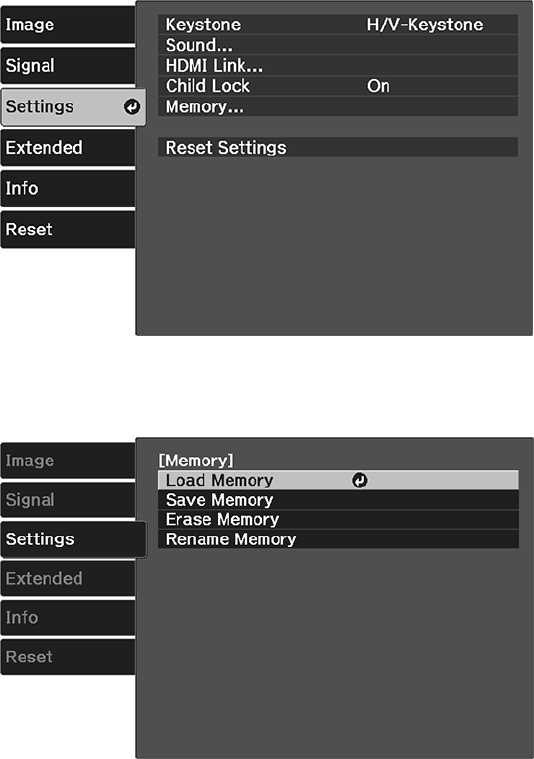
76
3. Select the Settings menu and press Enter.
4. Select Memory and press Enter.
5. Select one of the following options:
• Load Memory: Overwrites your current settings with saved settings
• Save Memory: Saves your current settings to memory

77
Note: A memory name that has already been used is indicated by a blue mark. Saving over a
previously saved memory overwrites the settings with your current settings.
• Erase Memory: Erases the selected memory settings
Note: To delete all saved memories, select Reset Memory in the Reset menu.
• Rename Memory: Renames a saved memory
6. Press the menu button or the return button to exit the menus.
Note: Each memory name shows the saved color mode next to it.
Parent topic: Adjusting Projector Features
Related references
Projector Reset Options - Reset Menu
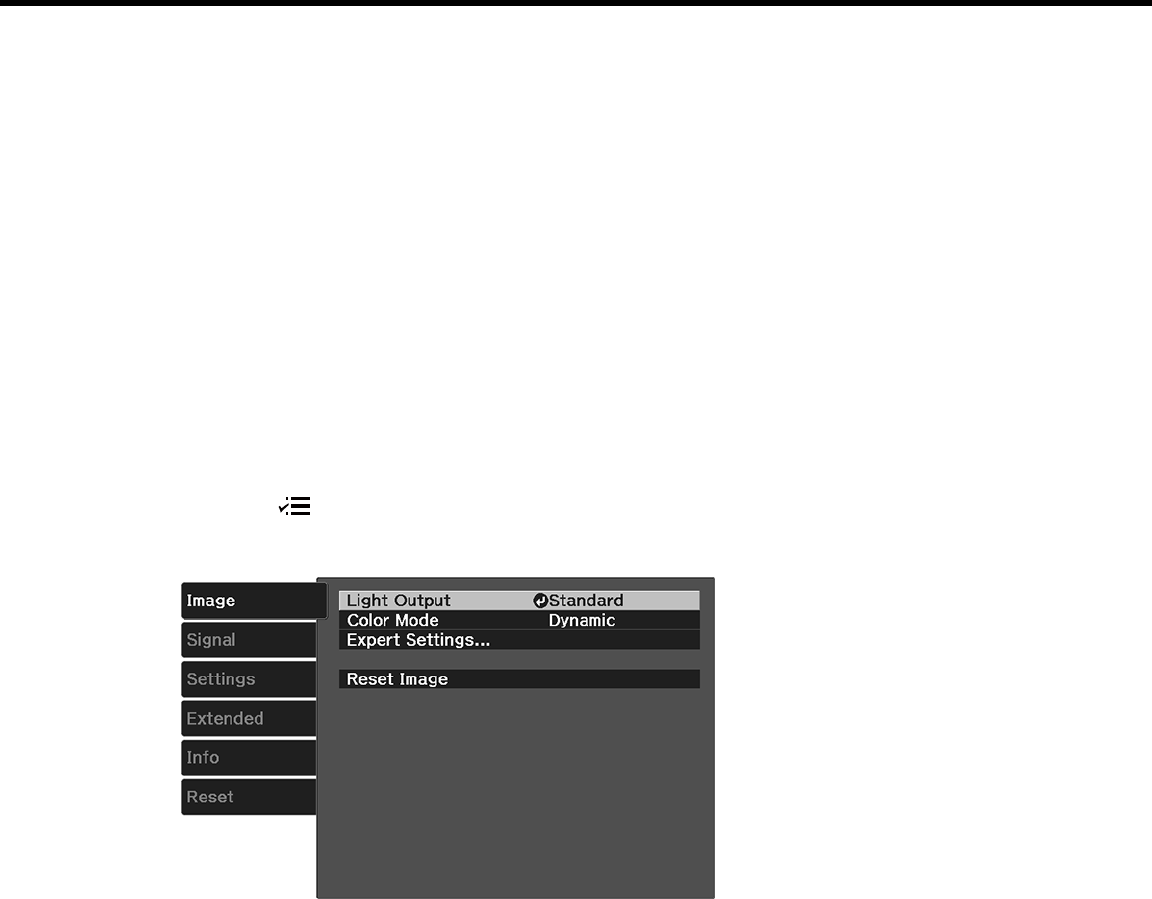
78
Adjusting the Menu Settings
Follow the instructions in these sections to access the projector menu system and change projector
settings.
Using the Projector's Menus
Using the Displayed Keyboard
Image Quality Settings - Image Menu
Input Signal Settings - Signal Menu
Projector Feature Settings - Settings Menu
Projector Setup Settings - Extended Menu
Projector Information Display - Info Menu
Projector Reset Options - Reset Menu
Using the Projector 's Menus
You can use the projector's menus to adjust the settings that control how your projector works. The
projector displays the menus on the screen.
1. Press the menu button on the projector remote control.
You see a screen like this:

79
2. Press the up or down arrow button to move through the menus listed on the left. The settings for
each menu are displayed on the right.
Note: The available settings depend on the current input source.
3. To change settings in the displayed menu, press Enter.
4. Press the up or down arrow button to move through the settings.
5. Change the settings using the buttons listed on the bottom of the menu screens.
6. To return all the menu settings to their default values, select Reset.
7. When you finish changing settings on a menu, press the return button.
8. Press the menu button to exit the menu or the return button to return to the previous screen.
Parent topic: Adjusting the Menu Settings
Using the Displayed Keyboard
You can use the displayed keyboard to enter numbers and characters.
1. Use the arrow buttons on the remote control to highlight the number or character you want to enter
and press Enter.
Note: Each time you select the CAPS key, the characters change between upper case and lower
case. Each time you select the SYM1/2 key, the symbols enclosed by the frame change.
2. After entering the text, select Finish on the keyboard to confirm your entries. Select Cancel to
cancel entering text.
Available Keyboard Text
Parent topic: Adjusting the Menu Settings
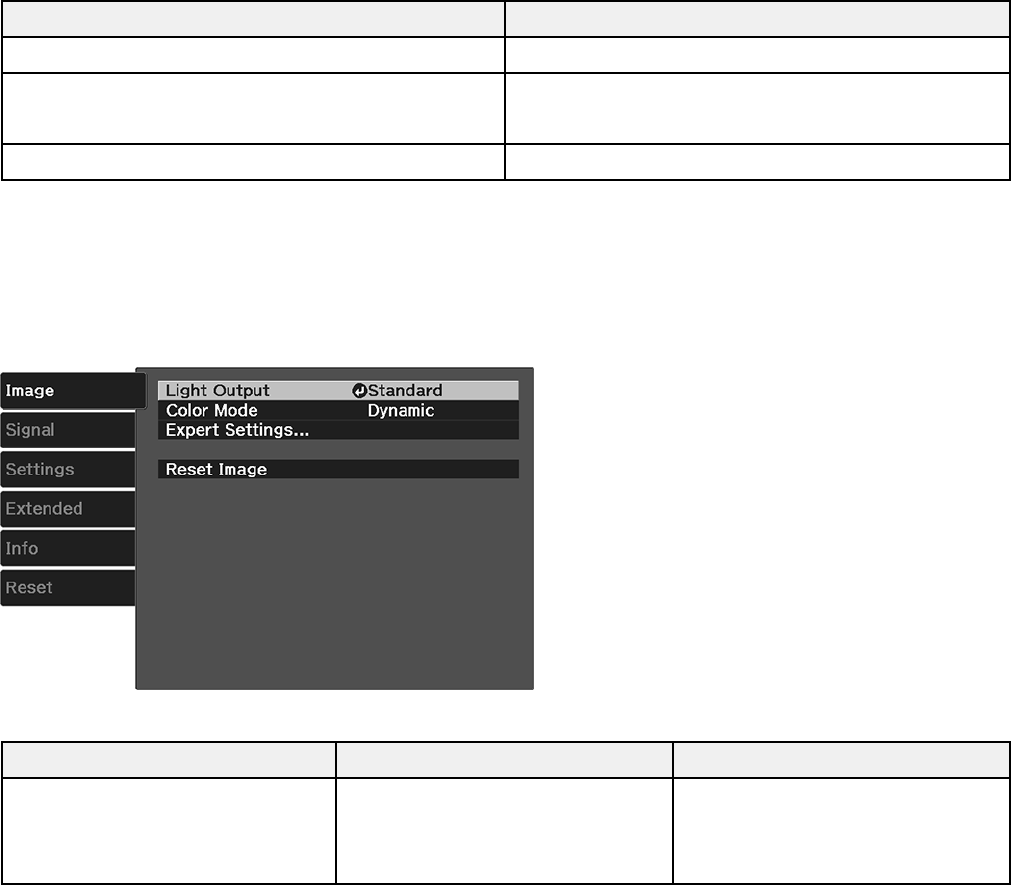
80
Available Keyboard Text
You can enter the following text when using the displayed keyboard.
Text type Details
Numbers 0123456789
Alphabet ABCDEFGHIJKLMNOPQRSTUVWXYZ
abcdefghijklmnopqrstuvwxyz
Symbols ! " # $ % & ' ( ) * + , - . / : ; < = > ? @ [ \ ] ^ _ ` { | } ~
Parent topic: Using the Displayed Keyboard
Image Quality Settings - Image Menu
Settings on the Image menu let you adjust the quality of your image for the input source you are currently
using. The available settings depend on the currently selected input source.
Setting Options Description
Light Output High
Standard
Low
Adjusts lamp brightness

81
Setting Options Description
Color Mode See the list of available Color
Modes
Adjusts the vividness of image
colors for various image types
and environments
Expert Settings Brightness Lightens or darkens the overall
image
Contrast Adjusts the difference between
light and dark areas in the image
Color Saturation Adjusts the color intensity of the
image
Tint Adjusts the balance of green to
magenta tones in the image
Sharpness Adjusts the sharpness or
softness of image details
White Balance Color Temp.: sets the color
temperature according to the
selected color mode; lower
values tint the image red, and
higher values tint the image blue
Custom: adjusts the individual
RGB components of the offset
and gain

82
Setting Options Description
Expert Settings Frame Interpolation Adjusts the smoothness of image
movement
Image Enhancement 4K Enhancement: projects at a
doubled resolution
Image Preset Mode: selects
preset Image Enhancement
settings
Noise Reduction: reduces
flickering in images
MPEG Noise Reduction:
reduces the noise or static in
MPEG video
Detail Enhancement: enhances
details to create clear outlines
Scene Adaptive Gamma Adjusts the color depending on
the displayed scene; larger
numbers enhance contrast
Gamma Adjusts the colors by selecting
one of the gamma correction
values or referring to a gamma
graph
RBGCMY Adjusts the hue, saturation, and
brightness for each color
Auto Iris Adjusts the projected luminance
based on the image brightness
Reset Image — Resets all adjustment values on
the Image menu to their default
settings.
Note: The Brightness setting does not affect lamp brightness. To change the lamp brightness, adjust
the Light Output setting.
Parent topic: Adjusting the Menu Settings
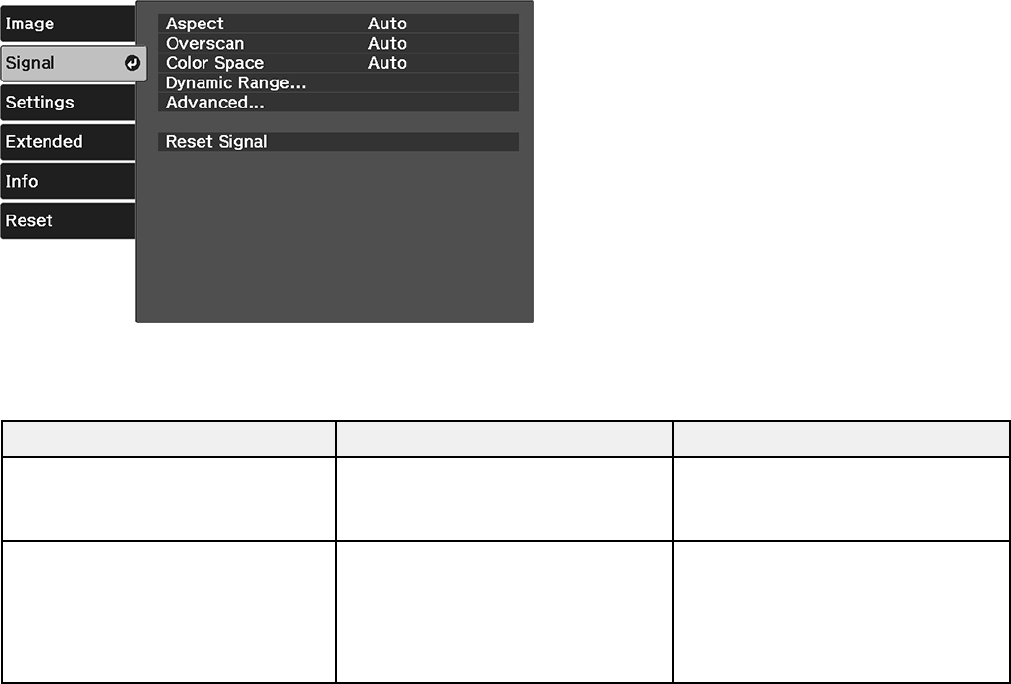
83
Related references
Available Color Modes
Input Signal Settings - Signal Menu
Normally the projector detects and optimizes the input signal settings automatically. If you need to
customize the settings, you can use the Signal menu. The available settings depend on the currently
selected input source.
To change settings for an input source, make sure the source is connected and select that source.
Setting Options Description
Aspect See the list of available aspect
ratios
Sets the aspect ratio (width-to-
height ratio) for the selected input
source
Overscan Auto
Off
4%
8%
Changes the projected image
ratio to make the edges visible by
a selectable percentage or
automatically

84
Setting Options Description
Color Space Auto
BT.709
BT.2020
Sets the conversion system for
the color space (set to Auto for
most cases)
Dynamic Range Dynamic Range Changes the range of dark and
bright areas in the image (set to
Auto for most cases)
Signal Status Displays the detected input
signal
HDR10 Setting Adjusts the PQ curve of the
dynamic range (available when
Dynamic Range or Signal
Status is set to HDR10)
HLG Setting Adjusts the HLG curve of the
dynamic range (available when
Dynamic Range or Signal
Status is set to HLG)

85
Setting Options Description
Advanced Video Range Sets the video range to match
the setting of the device
connected to the HDMI input port
Auto: detects the video range
automatically
Limited: for images from a
device other than a computer;
can also be selected if the black
areas of the image are too bright
Full: for images from a computer;
can also be selected if the image
is too dark
EDID Selects EDID settings
Normal: supports 3840 × 2160
30Hz signals
21:9: supports 2560 × 1080 60Hz
signals
Image Processing Improves the response speed for
images projected at high speed
Fast: increases image
processing speed
Fine: increase image quality
Reset Signal — Resets all adjustment values on
the Signal menu to their default
settings.
Parent topic: Adjusting the Menu Settings
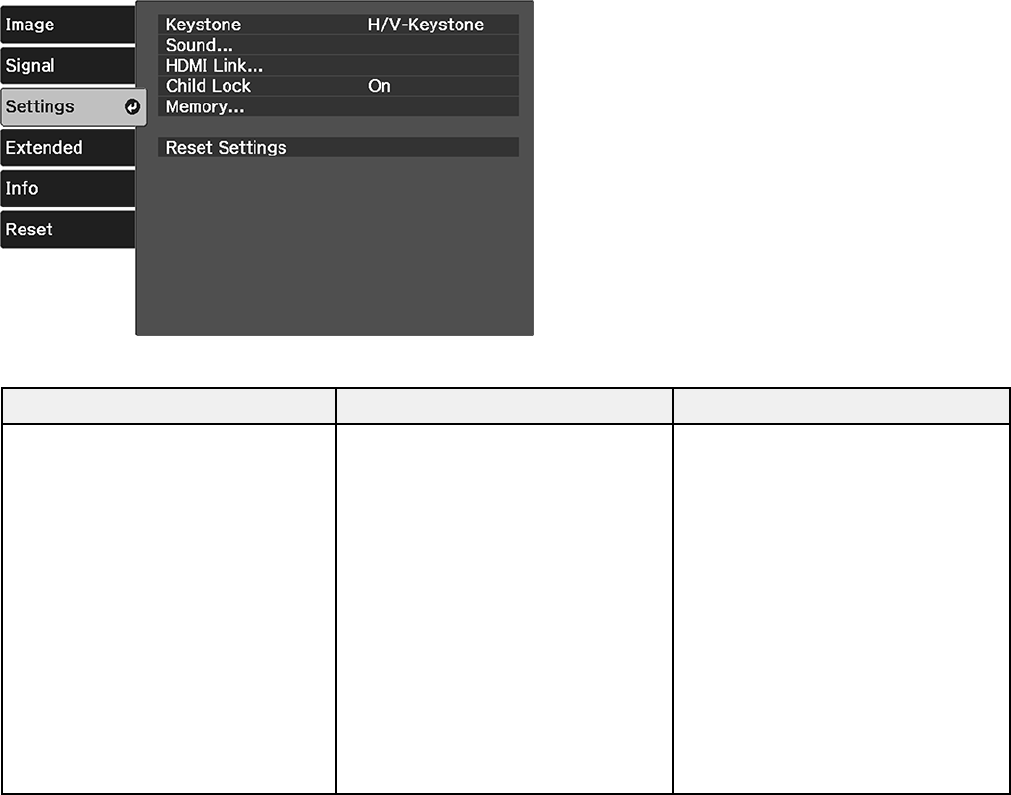
86
Projector Feature Settings - Settings Menu
Options on the Settings menu let you customize various projector features.
Setting Options Description
Keystone H/V-Keystone
Quick Corner
Adjusts image shape to
rectangular (horizontally and
vertically)
H/V-Keystone: lets you manually
correct horizontal and vertical
sides; turn on or off Auto V-
Keystone and the H-Keystone
Adjuster setting (Auto V-
Keystone only functions when
the Projection setting is set to
Front)
Quick Corner: select to correct
image shape and alignment
using an on-screen display

87
Setting Options Description
Sound Volume
Sound Mode
Adjusts the projector's sound
output
Volume: adjusts the volume of
the projector’s speaker system or
external device connected to the
Audio Out port
Sound Mode: selects a sound
mode depending on the
projected content
HDMI Link Device Connections
HDMI Link
Audio Out Device
Power On Link
Power Off Link
Adjusts the HDMI Link options
that allow the projector remote to
control HDMI-connected devices
that support the CEC standard
Device Connections: lists the
devices connected to the HDMI 1
and HDMI 2 ports
HDMI Link: enables or disables
the HDMI Link function
Audio Out Device: selects
whether to output audio from the
internal speakers or a connected
audio/video system
Power On Link: controls the
projector or a linked device
• Device -> PJ or Bidirectional:
turns on the projector when the
linked device is turned on
• PJ -> Device or Bidirectional:
turns on the linked device
when the projector is turned on
Power Off Link: controls
whether linked devices are
turned off when the projector is
turned off

88
Setting Options Description
Child Lock On
Off
Locks the power button
Memory Load Memory
Save Memory
Erase Memory
Rename Memory
Controls memory functions for
current projector settings
Load Memory: lets you load a
saved memory
Save memory: lets you save
current projector settings to
memory
Erase Memory: lets you delete a
saved memory
Rename Memory: lets you
rename a saved memory
Reset Settings — Resets all adjustment values on
the Settings menu to their
default settings, except for the
following:
• Audio Out Device
• Power On Link
• Power Off Link
• Memory
Note: Turning off your input devices will not power down the projector even if you select On as the
Power Off Link setting.
Parent topic: Adjusting the Menu Settings
Related references
Projector Setup Settings - Extended Menu
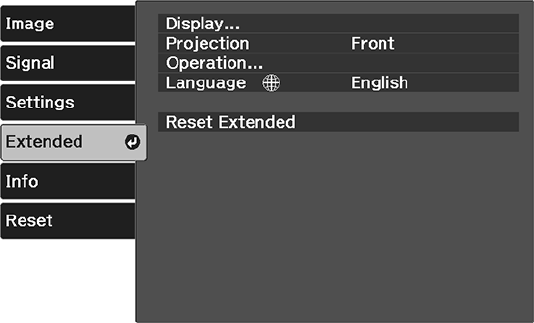
89
Projector Setup Settings - Extended Menu
Settings on the Extended menu let you customize various projector setup features that control its
operation.

90
Setting Options Description
Display Messages
Display Background
Startup Screen
Selects various display options
Messages: controls whether
messages are displayed on the
screen
Display Background: selects
the screen color or logo to
display when no signal is
received
Startup Screen: controls
whether a special screen
appears when the projector
starts up
Panel Alignment Corrects color misalignment in
the projected image
Panel Alignment: set to On to
correct color misalignment in the
projected image
Select Color: select the color to
correct
Pattern Color: select the pattern
used for correction
Start Adjustments: start panel
alignment
Memory: saves, loads, renames,
or erases panel alignment
settings
Reset: resets all panel alignment
settings to their defaults
Projection Front
Front/Ceiling
Rear
Rear/Ceiling
Selects the way the projector
faces the screen so the image is
oriented correctly

91
Setting Options Description
Operation Direct Power On Turns on the projector when you
plug it in
Sleep Mode Automatically places the
projector in standby mode after
an interval of inactivity
Sleep Mode Timer Sets the interval for sleep mode
Illumination Turns off the power and status
lights on the projector
High Altitude Mode Regulates the projector’s
operating temperature at
altitudes above 4921 feet
(1500 m)
USB Power Always On: continues supplying
power to the streaming media
player connected to the projector
even when it is not projecting
images
On While Projecting: supplies
power to the streaming media
player only when the projector is
projecting images
Language Various languages available Selects the language for
projector menu and message
displays (not changed by Reset
option)
Reset Extended — Resets all adjustment values on
the Extended menu to their
default settings, except for the
following:
• Projection
• High Altitude Mode
• USB Power
• Language

92
Parent topic: Adjusting the Menu Settings
Projector Information Display - Info Menu
You can display information about the projector and input sources by viewing the Info menu. However,
you cannot change any settings in the menu.
Select Version to display the projector's firmware version. Select Projector Info to display the settings
described below.
Information item Description
Lamp Hours Displays the number of hours (H) the lamp has been used; if the
information is displayed in yellow, obtain a genuine Epson
replacement lamp soon
Source Displays the name of the port to which the current input source is
connected
Input Signal Displays the input signal setting of the current input source
Resolution Displays the resolution of the current input source
Scan Mode Displays the scan mode of the current input source
Refresh Rate Displays the refresh rate of the current input source
Sync Info Displays information that may be needed by a service technician
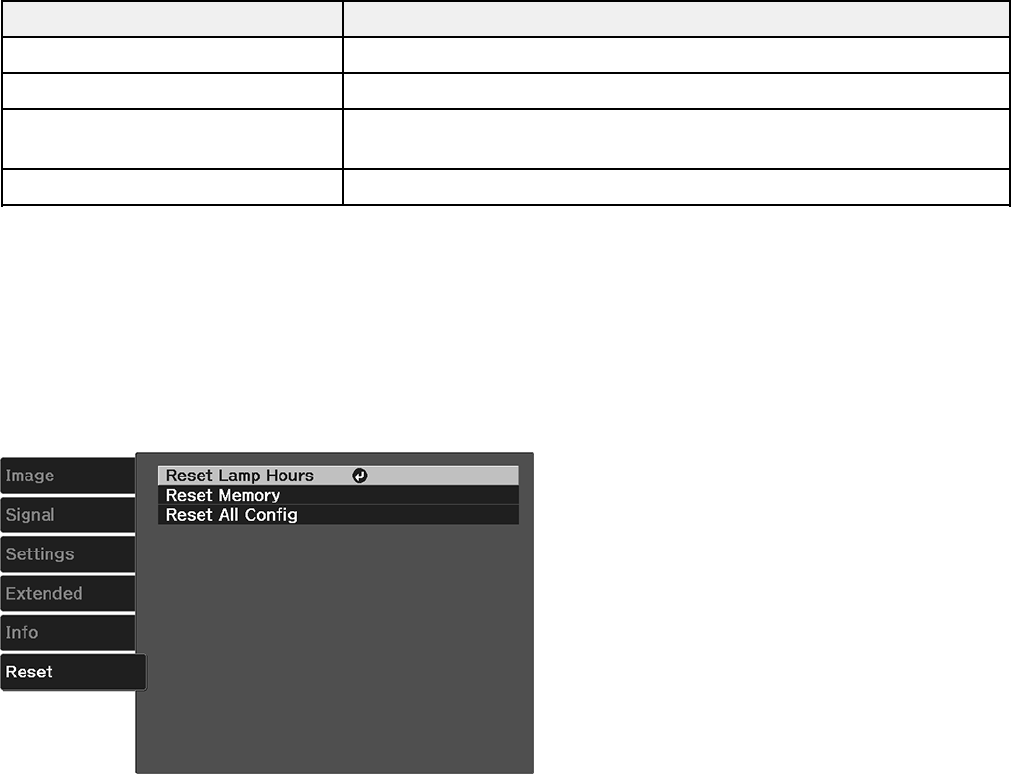
93
Information item Description
Color Depth Displays the color depth
Color Format Displays information on the Color Space and Dynamic Range
Status Displays information about projector problems that may be needed
by a service technician
Serial Number Displays the projector's serial number
Parent topic: Adjusting the Menu Settings
Projector Reset Options - Reset Menu
You can reset most of the projector settings to their default values using the Reset All Config option on
the Reset menu.
You can reset the projector's lamp usage timer to zero when you replace the lamp using the Reset
Lamp Hours option and you can also reset all memory entries using the Reset Memory option.
You cannot reset the following settings using the Reset All Config option:
• Language
• Lamp Hours
• Memory
• Panel Alignment

95
Maintaining and Transporting the Projector
Follow the instructions in these sections to maintain your projector and transport it from place to place.
Projector Maintenance
Removing the Streaming Device
Transporting the Projector
Projector Maintenance
Your projector needs little maintenance to keep working at its best.
You may need to clean the lens periodically, and clean the air filter and air vents to prevent the projector
from overheating due to blocked ventilation.
The only parts you should replace are the lamp, air filter, and remote control batteries. If any other part
needs replacing, contact Epson or an authorized Epson servicer.
Warning: Before cleaning any part of the projector, turn it off and unplug the power cord. Never open
any cover on the projector, except as specifically explained in this manual. Dangerous electrical voltages
in the projector can injure you severely.
Warning: Do not try to service this product yourself, except as specifically explained in this manual.
Refer all other servicing to qualified servicers.
Cleaning the Lens
Cleaning the Projector Case
Air Filter and Vent Maintenance
Projector Lamp Maintenance
Replacing the Remote Control Batteries
Parent topic: Maintaining and Transporting the Projector
Related references
Where to Get Help (U.S. and Canada)
Where to Get Help (Latin America)
Cleaning the Lens
Clean the projector's lens periodically, or whenever you notice dust or smudges on the surface. Make
sure you unplug the projector before cleaning the lens.
96
• To remove dust or smudges, gently wipe the lens with lens-cleaning paper.
• To remove stubborn smudges, moisten a soft, lint-free cloth with lens cleaner and gently wipe the
lens. Do not spray any liquid directly on the lens.
Warning: Do not use a lens cleaner that contains flammable gas. The high heat generated by the
projector lamp may cause a fire.
Caution: Do not wipe the lens immediately after turning off the projector; otherwise, the lens could be
damaged. Do not use glass cleaner or any harsh materials to clean the lens and do not subject the
lens to any impacts; you may damage it. Do not use canned air, or the gases may leave a residue.
Avoid touching the lens with your bare hands to prevent fingerprints on or damage to the lens surface.
Parent topic: Projector Maintenance
Cleaning the Projector Case
Before cleaning the projector case, turn off the projector and unplug the power cord.
• To remove dust or dirt, use a soft, dry, lint-free cloth.
• To remove stubborn dirt, use a soft cloth moistened with water and mild soap. Do not spray liquid
directly on the projector.
Caution: Do not use wax, alcohol, benzine, paint thinner, or other chemicals to clean the projector
case. These can damage the case. Do not use canned air, or the gases may leave a flammable
residue.
Parent topic: Projector Maintenance
Air Filter and Vent Maintenance
Regular filter maintenance is important to maintaining your projector. Your Epson projector is designed
with an easily accessible, user-replaceable filter to protect your projector and make regular maintenance
simple. Filter maintenance intervals will depend on the environment.
If regular maintenance is not performed, your Epson projector will notify you when the temperature
inside the projector has reached a high level. Do not wait until this warning appears to maintain your
projector filter as prolonged exposure to high temperatures may reduce the life of your projector or lamp.
Damage due to the failure to properly maintain the projector or its filter may not be covered by the
projector or lamp Limited Warranties.
Cleaning the Air Filter and Vents

97
Replacing the Air Filter
Parent topic: Projector Maintenance
Related references
Projector Light Status
Cleaning the Air Filter and Vents
Clean the projector's air filter or vents if they get dusty.
1. Turn off the projector and unplug the power cord.
2. Gently remove the dust from the air intake vent using a small vacuum designed for computers or a
very soft brush (such as a paintbrush).
Note: Do not vacuum the air filter, or you may damage it. Do not rinse the air filter in water or use
any detergent or solvent to clean it.
Caution: Do not use canned air. The gases may leave a flammable residue or push dust and debris
into the projector's optics or other sensitive areas.
Caution: If the streaming media player is not installed, disconnect the HDMI and power supply USB
cables from the projector during cleaning. Otherwise, the ports of the cables may get dusty, resulting
in a malfunction.
3. If dust is difficult to remove or the air filter is damaged, replace the air filter.
Parent topic: Air Filter and Vent Maintenance

98
Related tasks
Replacing the Air Filter
Replacing the Air Filter
You need to replace the air filter in the following situations:
• The air filter is torn or damaged
• Dust on the filter is difficult to remove
You can replace the air filter while the projector is mounted to the ceiling or placed on a table.
1. Turn off the projector and unplug the power cord.
2. Remove the rear cover and air filter cover.
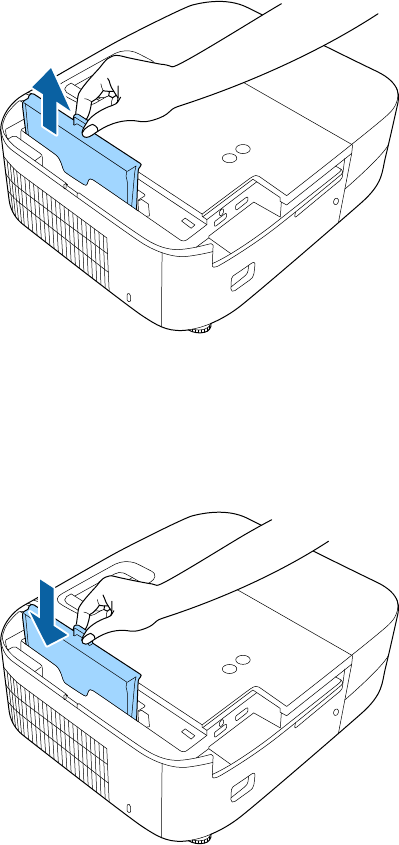
99
3. Pull the air filter out of the projector.
Note: Air filters contain ABS resin and polyurethane foam. Dispose of used air filters according to
local regulations.
4. Place the new air filter in the projector as shown and push gently until it clicks into place.
5. Replace the rear cover and air filter cover.
100
Parent topic: Air Filter and Vent Maintenance
Related references
Optional Equipment and Replacement Parts
Projector Lamp Maintenance
The projector keeps track of the number of hours the lamp is used and displays this information in the
projector's menu system.
Replace the lamp as soon as possible when the following occurs:
• The projected image gets darker or starts to deteriorate
• A message appears when you turn on the projector telling you to replace the lamp
• The projector's power light is flashing blue and its lamp light is flashing orange.
Caution: If you continue to use the lamp after the above conditions occur, the possibility that the lamp
may explode increases. When the lamp replacement message appears, replace the lamp with a new
one as soon as possible, even if it is still working. You should always have a spare lamp unit ready in
case it is needed.
Caution: Do not repeatedly turn the projector power on and off. This may shorten the lamp's operating
life.
Note: We recommend the use of genuine Epson replacement lamps. The use of non-genuine lamps
may affect projection quality and safety. Any damage or malfunction caused by the use of non-genuine
lamps may not be covered by Epson's warranty.
Replacing the Lamp
Resetting the Lamp Timer
Parent topic: Projector Maintenance
Related references
Optional Equipment and Replacement Parts
Projector Information Display - Info Menu
Projector Lamp Specifications
Replacing the Lamp
Before you replace the lamp, let the projector cool down for at least one hour so the lamp will not be hot.

101
Warning: Let the lamp fully cool before replacing it to avoid injury.
You can replace the lamp while the projector is mounted to the ceiling, if necessary.
1. Turn off the projector and unplug the power cord.
2. Allow the projector lamp to cool down for at least one hour.
3. Use the screwdriver included with the replacement lamp to loosen the screw securing the lamp
cover.
Warning: If the lamp is broken, glass fragments may be loose inside the lamp chamber. Be careful
removing any broken glass to avoid injury. If the projector is installed on the ceiling, stand to the side
of the lamp cover and not underneath it; pieces of glass could fall into your eyes or mouth when you
open the lamp cover.

102
4. Slide the lamp cover out and lift it off.
5. Loosen the screws securing the lamp to the projector. The screws do not come all the way out.

103
6. Grasp the raised section of the lamp and gently pull the lamp out of the projector.
Note: The lamp(s) in this product contain mercury. Please consult your state and local
regulations regarding disposal or recycling. Do not put in the trash.
Note: If the lamp is cracked, contact Epson for help.
7. Gently insert the new lamp into the projector. If it does not fit easily, make sure it is facing the right
way.
Caution: Do not touch any glass on the lamp assembly to avoid premature lamp failure.

104
8. Push in the lamp firmly and tighten the screws to secure it.
Caution: Do not over-tighten the screws.
9. Replace the lamp cover and tighten the screw to secure it.
Note: Be sure the lamp cover is securely installed or the lamp will not come on.
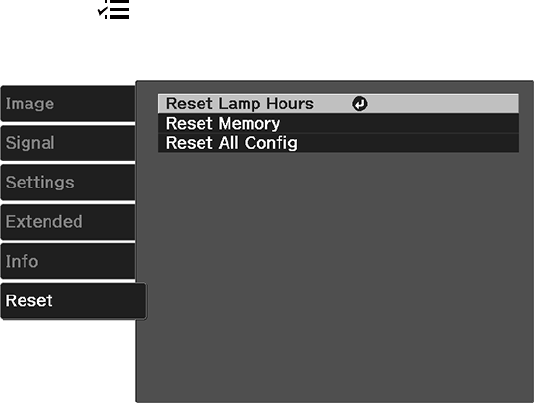
105
Reset the lamp timer to zero to keep track of the new lamp's usage.
Parent topic: Projector Lamp Maintenance
Related references
Optional Equipment and Replacement Parts
Related tasks
Resetting the Lamp Timer
Resetting the Lamp Timer
You must reset the lamp timer after replacing the projector's lamp to clear the lamp replacement
message and to keep track of lamp usage correctly.
Note: Do not reset the lamp timer if you have not replaced the lamp to avoid inaccurate lamp usage
information.
1. Turn on the projector.
2. Press the menu button.
3. Select the Reset menu and press Enter.
4. Select Reset Lamp Hours and press Enter.
You see a prompt asking if you want to reset the lamp hours.
5. Select Yes and press Enter.

106
6. Press the menu button or the return button to exit the menus.
Parent topic: Projector Lamp Maintenance
Related tasks
Replacing the Lamp
Replacing the Remote Control Batteries
The remote control uses two AAA manganese or alkaline batteries. Replace the batteries as soon as
they run out.
Caution: Use only the type of batteries specified in this manual. Do not install batteries of different types,
or mix new and old batteries.
1. Remove the battery cover as shown.
2. Remove the old batteries.
Warning: If the battery fluid has leaked, wipe it away with a soft cloth and avoid getting the fluid on
your hands. If it gets on your hands, wash them immediately to avoid injury.
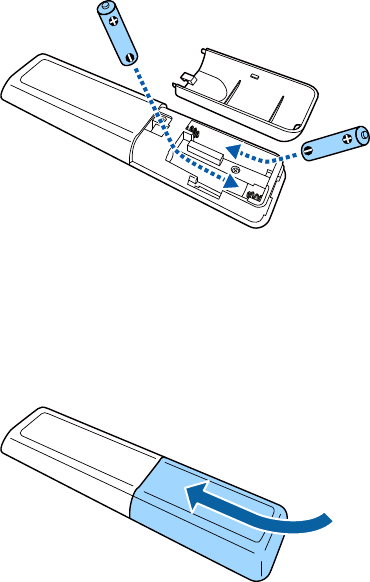
107
3. Insert the batteries with the + and – ends facing as shown.
Warning: Make sure the batteries are inserted in the correct positions. If the batteries are not
inserted correctly, they could explode or leak, causing a fire, injury, or damage to the product.
4. Replace the battery cover and press it down until it clicks into place.
Warning: Dispose of used batteries according to local regulations. Do not expose batteries to heat
or flame. Keep batteries out of the reach of children; they are choking hazards and are very
dangerous if swallowed.
Parent topic: Projector Maintenance
Removing the Streaming Device
You need to remove the projector's built-in streaming device if it needs to be sent back to Epson for
repairs. You can also remove the streaming device to connect it to a different video device or projector.
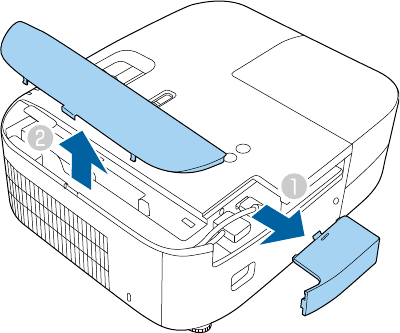
108
Note: If the streaming device is sent for repairs, it may be reset and you may need to re-enter your
account information for each streaming app.
Note: If you connect the streaming device to a different video device or projector, use the remote control
for Android TV.
1. Turn off the projector and unplug the power cord.
2. Remove the rear cover and air filter cover.
110
Related references
Projector Parts - Remote Control
Where to Get Help (U.S. and Canada)
Where to Get Help (Latin America)
Transporting the Projector
The projector contains precision parts, some of which are glass. Follow these guidelines to transport,
ship, or store the projector safely:
• Remove any equipment connected to the projector.
• When transporting the projector a long distance or as checked luggage, pack it in a firm box with
cushioning around it and mark the box "Fragile."
• When shipping the projector for repairs, place it in its original packing materials, if possible, or use
equivalent materials with cushioning around the projector. Mark the box "Fragile."
Note: Epson shall not be liable for any damages incurred during transportation.
Parent topic: Maintaining and Transporting the Projector

111
Solving Problems
Check the solutions in these sections if you have any problems using the projector.
Projection Problem Tips
Projector Light Status
Solving Image or Sound Problems
Solving Projector or Remote Control Operation Problems
Solutions to HDMI Link Problems
Where to Get Help (U.S. and Canada)
Where to Get Help (Latin America)
Projection Problem Tips
If the projector is not working properly, try turning it off and unplugging it. Then plug it back in and turn it
on.
If this does not solve the problem, check the following:
• The lights on the projector may indicate what the problem is.
• The solutions in this manual can help you solve many problems.
If none of these solutions help, you can contact Epson for technical support.
Note: After repairing the projector, Epson may return the projector to you in its initial status. Make sure
you make a note of the account information of each online service before you contact your local dealer or
the nearest Epson repair center.
Parent topic: Solving Problems
Related references
Projector Light Status
Where to Get Help (U.S. and Canada)
Where to Get Help (Latin America)
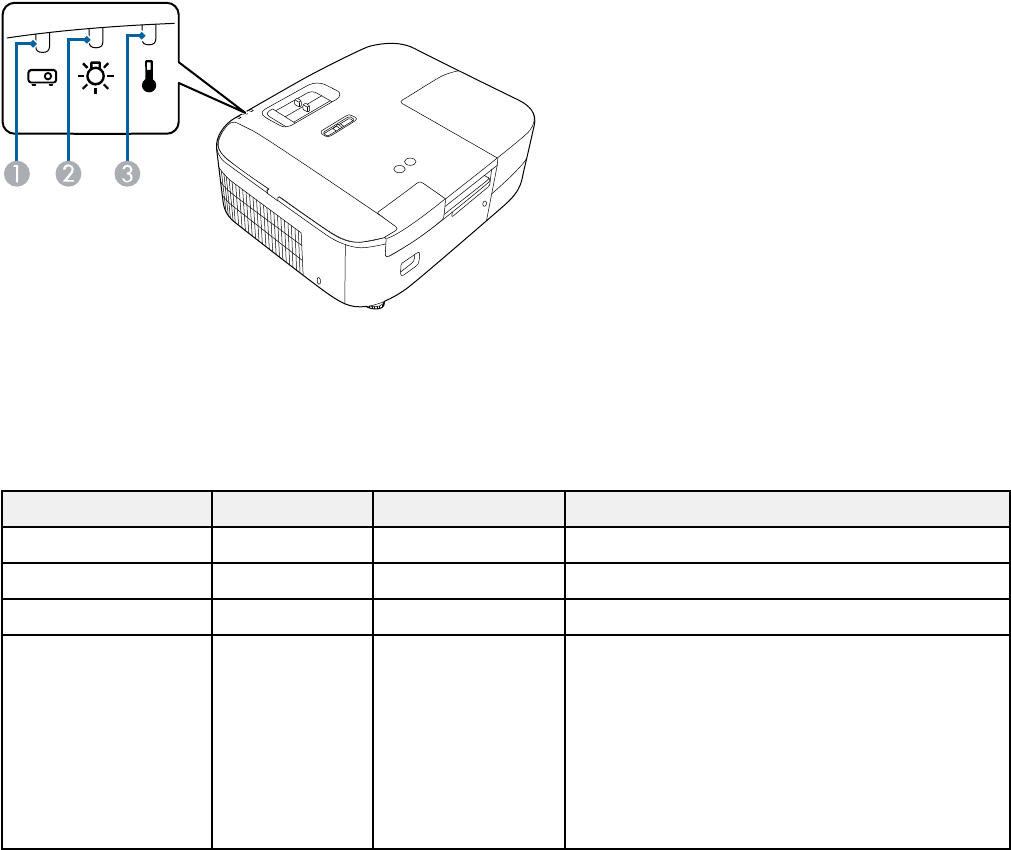
112
Projector Light Status
The lights on the projector indicate the projector status and let you know when a problem occurs. Check
the status and color of the lights and look for a solution in the table here.
1 Status light
2 Lamp light
3 Temp (temperature) light
Status light Lamp light Temp light Status and solution
Blue Off Off Normal operation
Flashing blue Off Off Warming up or cooling down
Off Off Off Standby or sleep mode
Varies Off Flashing orange Projector is too hot
• Make sure that the vents and air filter are
not clogged with dust or obstructed by
nearby objects
• Clean or replace the air filter
• Make sure the environmental temperature
is not too hot

113
Status light Lamp light Temp light Status and solution
Off Off Orange Projector has overheated and turned off;
leave it turned off to cool down for about five
minutes, then do the following:
• Make sure that the vents and air filter are
not clogged with dust or obstructed by
nearby objects
• Clean or replace the air filter
• Make sure the environmental temperature
is not too hot
• If operating the projector at high altitude,
turn on High Altitude Mode
• If the problem persists, unplug the
projector and contact Epson for help
Off Orange Off Lamp or lamp cover has a problem
• Check to see if the lamp is burned out,
broken, or installed incorrectly; reseat or
replace the lamp as necessary
• Clean the air filter
• If operating the projector at high altitude,
turn on High Altitude Mode
• Check that the lamp cover is installed
correctly
• If the problem persists, unplug the
projector and contact Epson for help
Varies Flashing
orange
Off Replace the lamp soon to avoid damage; do
not continue using the projector
Off Orange Orange Internal projector error; turn the projector off,
unplug it, and contact Epson for help
Note: If the lights display a pattern not listed in the table above, turn the projector off, unplug it, and
contact Epson for help.

114
Parent topic: Solving Problems
Related tasks
Cleaning the Air Filter and Vents
Replacing the Air Filter
Replacing the Lamp
Solving Image or Sound Problems
Check the solutions in these sections if you have any problems with projected images or sound.
Solutions When No Image Appears
Solutions When "No Signal" Message Appears
Solutions When "Not Supported" Message Appears
Solutions When Only a Partial Image Appears
Solutions When the Image is Not Rectangular
Solutions When the Image Contains Noise or Static
Solutions When the Image is Fuzzy or Blurry
Solutions When the Image Brightness or Colors are Incorrect
Solutions When the Image is Upside Down
Solutions to Sound Problems
Parent topic: Solving Problems
Solutions When No Image Appears
If no image appears, try the following solutions:
• Make sure the lens cover is off.
• Press the A/V mute button on the projector remote control to see if the image was temporarily
turned off.
• Check the status lights to confirm the projector is operating normally.
• Make sure all necessary cables are securely connected and the power is on for the projector and
connected video sources.
• Try using a shorter HDMI cable.
• Try connecting the video source directly to the projector.
• Press the projector's power button to wake it from standby or sleep mode. Also see if your connected
computer is in sleep mode or displaying a blank screen saver.

115
• If you are projecting from a streaming device, make sure it is powered by the USB power cable inside
the projector. Turn on the connected streaming device or video source, and press the play button to
start a video, if necessary.
• Make sure the connected device meets the HDMI CEC standard. See the documentation supplied
with the device for more information. If necessary, set the CEC function for the connected device
again and restart the device. Turn off the projector and the connected streaming device or video
source, and then turn them back on.
• If you are projecting from a laptop computer, make sure it is set up to display on an external monitor.
• Make sure the computer's display resolution does not exceed the projector's resolution and frequency
limits. If necessary, select a different display resolution for your computer. (See your computer manual
for details.)
• If the other solutions do not solve the problem, reset all of the projector settings using the options on
the Reset menu.
Parent topic: Solving Image or Sound Problems
Related references
Projector Light Status
Image Quality Settings - Image Menu
Input Signal Settings - Signal Menu
Projector Setup Settings - Extended Menu
Related tasks
Turning On the Projector
Shutting Off the Picture and Sound Temporarily
Solutions When "No Signal" Message Appears
If the "No Signal" message appears, try the following solutions:
• Press the source button on the projector remote control or control panel and then select from the
displayed sources. Wait a few seconds for an image to appear.
• Turn on the connected computer or video source, and press its play button to begin your presentation,
if necessary.
• Check the connection from the projector to your video sources.
• If you are projecting from a laptop computer, make sure it is set up to display on an external monitor.
• If necessary, turn the projector and the connected computer or video source off and then on again.
• Try a different video cable.
116
• If the other solutions do not solve the problem, reset all of the projector settings using the options on
the Reset menu.
Displaying From a PC Laptop
Displaying From a Mac Laptop
Parent topic: Solving Image or Sound Problems
Related concepts
Projector Connections
Displaying From a PC Laptop
If you see the "No Signal" message when you display from a PC laptop, you need to set up the laptop to
display on an external monitor.
1. Hold down the laptop's Fn key and press the key labeled with a monitor icon or CRT/LCD. (See your
laptop manual for details.) Wait a few seconds for an image to appear. To display on both the
laptop's monitor and the projector, try pressing the same keys again.
Note: On Windows 7 or later, hold down the Windows key and press P at the same time, then click
Duplicate.
2. If the same image is not displayed by the laptop and projector, check the Windows Display utility to
make sure the external monitor port is enabled and extended desktop mode is disabled. (See your
computer or Windows manual for instructions.)
3. If necessary, check your video card settings and set the multiple display option to Clone, Mirror, or
Duplicate.
Parent topic: Solutions When "No Signal" Message Appears
Displaying From a Mac Laptop
If you see the "No Signal" message when you display from a Mac laptop, you need to set up the laptop
for mirrored display. (See your laptop manual for details.)
1. Open the System Preferences utility and select Displays, Display, or Color LCD.
2. Click the Arrange or Arrangement tab.
3. Select the Mirror Displays checkbox.
Parent topic: Solutions When "No Signal" Message Appears
117
Solutions When "Not Supported" Message Appears
If the "Not Supported" message appears, try the following solutions:
• Make sure the computer's display resolution does not exceed the projector's resolution and frequency
limit. If necessary, select a different display resolution for your computer. (See your computer manual
for details.)
• As a test, try setting the computer's display resolution to the lowest possible setting, and then
gradually increase it as necessary.
• Check the input resolution under Projector Info in the Info menu and make sure that the projector
supports that resolution.
Parent topic: Solving Image or Sound Problems
Related references
Projector Information Display - Info Menu
Supported Video Display Formats
Solutions When Only a Partial Image Appears
If only a partial computer image appears, try the following solutions:
• Select a different image aspect ratio in the Signal menu.
• Adjust the image size using the Zoom slider.
• Check your computer display settings to disable dual display and set the resolution within the
projector's limits. (See your computer manual for details.)
• Check the resolution assigned to your presentation files to see if they are created for a different
resolution than you are projecting in. (See your software help for details.)
• Make sure you selected the correct Projection setting in the Extended menu.
Parent topic: Solving Image or Sound Problems
Related references
Input Signal Settings - Signal Menu
Supported Video Display Formats
Solutions When the Image is Not Rectangular
If the projected image is not evenly rectangular, try the following solutions:
• Place the projector directly in front of the center of the screen, facing it squarely, if possible.
118
• Adjust the image shape using the keystone settings in the projector's menu.
• Adjust the position of the projector's horizontal keystone slider.
Parent topic: Solving Image or Sound Problems
Related concepts
Image Shape
Related references
Projector Feature Settings - Settings Menu
Solutions When the Image Contains Noise or Static
If the projected image seems to contain electronic interference (noise) or static, try the following
solutions:
• Check the cables connecting your computer or video source to the projector. They should be:
• Separated from the power cord to prevent interference
• Securely connected at both ends
• Not connected to an extension cable
• No longer than 24 feet (7.3 m) for HDMI cables
• Try decreasing the Sharpness setting in the Image menu.
• Try adjusting the Noise Reduction or MPEG Noise Reduction setting in the Image menu.
• Select a computer video resolution and refresh rate that are compatible with the projector.
• If you connected an extension power cable, try projecting without it to see if it caused interference in
the signal.
Parent topic: Solving Image or Sound Problems
Related references
Input Signal Settings - Signal Menu
Image Quality Settings - Image Menu
Supported Video Display Formats
Solutions When the Image is Fuzzy or Blurry
If the projected image is fuzzy or blurry, try the following solutions:
• Adjust the image focus.
119
• Clean the projector lens.
Note: To avoid condensation on the lens after bringing the projector in from a cold environment, let the
projector warm up to room temperature before using it.
• Position the projector close enough to the screen.
• Position the projector so the keystone adjustment angle is not so wide that it distorts the image.
• Adjust the Sharpness setting to improve image quality.
• If you are projecting from a computer, try using a lower resolution or try to match the projector's native
resolution.
Parent topic: Solving Image or Sound Problems
Related references
Image Quality Settings - Image Menu
Projection Distance
General Projector Specifications
Related tasks
Cleaning the Lens
Focusing the Image Using the Focus Slider
Solutions When the Image Brightness or Colors are Incorrect
If the projected image is too dark or light, or the colors are incorrect, try the following solutions:
• Try selecting a color mode that best fits the image and environment.
• Check your video source settings.
• Adjust the available settings on the Image menu for the current input source, such as Brightness,
Contrast, Tint, and/or Color Saturation.
• Make sure you selected the correct Video Range setting on the Signal menu, if available for your
image source.
Note: For screen sizes above 300″, a high-gain screen and a light-controlled environment may be
required.
• Make sure all the cables are securely connected to the projector and your video device. If you
connected long cables, try connecting shorter cables.

120
• Position the projector close enough to the screen.
• If the image has been progressively darkening, you may need to replace the projector lamp soon.
Parent topic: Solving Image or Sound Problems
Related references
Image Quality Settings - Image Menu
Projector Setup Settings - Extended Menu
Projector Lamp Specifications
Related tasks
Replacing the Lamp
Solutions When the Image is Upside Down
If the projected image is upside down, make sure you selected the correct Projection setting in the
Extended menu.
Parent topic: Solving Image or Sound Problems
Related references
Projector Setup Settings - Extended Menu
Related tasks
Connecting to a Computer for HDMI Video and Audio
Solutions to Sound Problems
If there is no sound when you expect it or the volume is too low or high, try the following solutions:
• Adjust the projector's volume settings.
• Press the A/V mute button on the projector remote control to resume video and audio if they were
temporarily stopped.
• Make sure the Audio Out Device settings are correct.
• Check your computer or video source to make sure the volume is turned up and the audio output is set
for the correct source.
• Check the audio out cable connection between the projector and your external speakers.
• If you do not hear sound from an HDMI source, set the connected device to PCM output.
• If you are using a Mac and you do not hear sound from an HDMI source, make sure your Mac
supports audio through the HDMI port. If not, you need to connect an audio cable directly to your
speaker system.
121
Parent topic: Solving Image or Sound Problems
Related concepts
Projector Connections
Related tasks
Controlling the Volume with the Volume Buttons
Shutting Off the Picture and Sound Temporarily
Solving Projector or Remote Control Operation Problems
Check the solutions in these sections if you have problems operating the projector or remote control.
Note: For Android TV support, visit https://support.google.com/androidtv/.
Solutions to Projector Power or Shut-Off Problems
Solutions to Remote Control Problems
Parent topic: Solving Problems
Solutions to Projector Power or Shut-Off Problems
If the projector does not come on when you press the power button or it shuts off unexpectedly, try the
following solutions:
• Make sure the power cord is securely connected to the projector and to a working electrical outlet.
• The projector's power button may be locked for security. Unlock it or use the projector remote control
to turn on the projector.
• If the power button on the remote control does not turn on the projector, check its batteries.
• Make sure you are using the projector remote control and not the remote control for Android TV.
• Make sure Sleep Mode is not in effect. Perform any operation to wake the projector. To turn off Sleep
Mode, select Off as the Sleep Mode setting.
• The power cord may be defective. Try another power cord. If that doesn't work, disconnect the cord
and contact Epson.
• The cooling fans may run in standby status depending on the projector settings. Also, when the
projector wakes from standby status, the fans may cause an unexpected noise. This is not a
malfunction.
Parent topic: Solving Projector or Remote Control Operation Problems
122
Related references
Where to Get Help (U.S. and Canada)
Where to Get Help (Latin America)
Projector Light Status
Projector Feature Settings - Settings Menu
Projector Setup Settings - Extended Menu
Related tasks
Replacing the Remote Control Batteries
Replacing the Lamp
Locking the Projector's Power Button
Solutions to Remote Control Problems
If the projector does not respond to remote control commands, try the following solutions:
• Check that the remote control batteries are installed correctly and have power. If necessary, replace
the batteries.
• Make sure you are operating the remote control within the reception angle and range of the projector.
• Make sure the projector is not warming up or shutting down.
• Check to see if a button on the remote control is stuck down, causing it to enter sleep mode. Release
the button to wake the remote control up.
• Make sure the projector remote control is paired to the streaming device to operate Android TV
features (if applicable).
• Make sure you are using the projector remote control and not the remote control for Android TV.
• Strong fluorescent lighting, direct sunlight, or infrared device signals may be interfering with the
projector's remote receivers. Dim the lights or move the projector away from the sun or interfering
equipment.
• If you lose the remote control, you can purchase another from an Epson parts distributor.
Parent topic: Solving Projector or Remote Control Operation Problems
Related references
Optional Equipment and Replacement Parts
Remote Control Operation
Projector Setup Settings - Extended Menu
123
Related tasks
Pairing the Projector Remote Control
Replacing the Remote Control Batteries
Solutions to HDMI Link Problems
If you cannot control an HDMI device using the HDMI Link feature, try the following solutions:
• Make sure all necessary cables are securely connected and the power is on for the projector and
connected video sources.
• Make sure the cables meet the HDMI CEC standard.
• Make sure the connected device meets the HDMI CEC standard. See the documentation supplied
with the device for more information.
• Replace the HDMI cable or try a shorter one.
• Make sure the HDMI Link setting is set to On.
• Check if the device is available in the Device Connections list in the Settings menu. If the device
does not appear, it does not meet the HDMI CEC standards. Connect a different device.
• Make sure the connected devices are turned on and in standby status. See the documentation
supplied with the device for more information.
• If you connected a new device or changed any connections, make sure the CEC function is set for the
connected device. You may need to restart the device.
Parent topic: Solving Problems
Related references
Projector Feature Settings - Settings Menu
Where to Get Help (U.S. and Canada)
If you need to contact Epson for technical support services, use the following support options.
Internet Support
Visit Epson's support website at epson.com/support (U.S.) or epson.ca/support (Canada) and select
your product for solutions to common problems with your projector. You can download utilities and
documentation, get FAQs and troubleshooting advice, or e-mail Epson with your questions.
124
Speak to a Support Representative
To use the Epson PrivateLine Support service, call (800) 637-7661. This service is available for the
duration of your warranty period. You may also speak with a projector support specialist by dialing
(562) 276-4394 (U.S.) or (905) 709-3839 (Canada).
Support hours are Monday through Friday, 7 AM to 4 PM, Pacific Time.
Days and hours of support are subject to change without notice. Toll or long distance charges may
apply.
Before you call, have the following information ready:
• Product name
• Product serial number (located on the bottom or rear of the projector, or in the menu system)
• Proof of purchase (such as a store receipt) and date of purchase
• Computer or video configuration
• Description of the problem
Purchase Supplies and Accessories
You can purchase screens, other optional accessories, and replacement parts from an Epson authorized
reseller. To find the nearest reseller, call 800-GO-EPSON (800-463-7766) in the U.S. or 800-807-7766 in
Canada. Or you can purchase online at epsonstore.com (U.S. sales) or epsonstore.ca (Canadian sales).
You can purchase a replacement remote control from an Epson parts distributor here (U.S. sales) or
here (Canadian sales).
Parent topic: Solving Problems
Where to Get Help (Latin America)
If you need to contact Epson for technical support services, use the following support options.
Internet Support
Visit Epson's support website at latin.epson.com/support and select your product for solutions to
common problems with your projector. You can download utilities and documentation, get FAQs and
troubleshooting advice, or e-mail Epson with your questions.
Speak to a Support Representative
Before you call for support, please have the following information ready:
• Product name
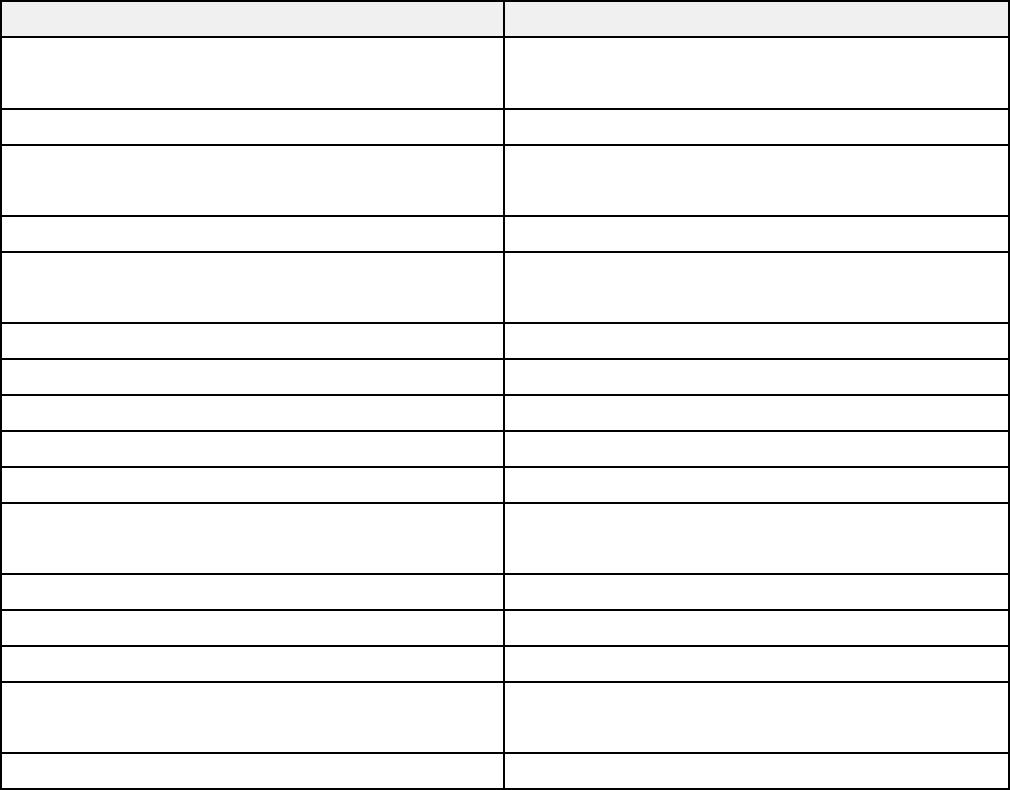
125
• Product serial number (located on the bottom or rear of the projector, or in menu system)
• Proof of purchase (such as a store receipt) and date of purchase
• Computer or video configuration
• Description of the problem
Then call:
Country Telephone
Argentina (54 11) 5167-0300
0800-288-37766
Bolivia* 800-100-116
Brazil State capitals and metropolitan areas: 3004-6627
Other areas: 0800-377-6627 / 0800-EPSONBR
Chile (56 2) 2484-3400
Colombia Bogota: (57 1) 602-4751
Other cities: 01-8000-915235
Costa Rica 800-377-6627
Dominican Republic* 1-888-760-0068
Ecuador* 1-800-000-044
El Salvador* 800-6570
Guatemala* 1-800-835-0358
Mexico Mexico City: (52 55) 1323-2052
Other cities: 01-800-087-1080
Nicaragua* 00-1-800-226-0368
Panama* 00-800-052-1376
Paraguay 009-800-521-0019
Peru Lima: (51 1) 418-0210
Other cities: 0800-10126
Uruguay 00040-5210067

126
Country Telephone
Venezuela (58 212) 240-1111
*Contact your local phone company to call this toll-free number from a mobile phone.
Note: Toll or long distance charges may apply. If your country does not appear on the list, contact the
sales office in the nearest country.
Purchase Supplies and Accessories
You can purchase optional accessories and replacement parts from an Epson authorized reseller. To
find the nearest reseller, go to latin.epson.com. Or you can contact your nearest sales office as
described in "Where to Get Help."
Parent topic: Solving Problems

127
Technical Specifications
These sections list the technical specifications of your projector.
General Projector Specifications
Projector Lamp Specifications
Remote Control Specifications
Bluetooth Specifications
Projector Dimension Specifications
Projector Electrical Specifications
Projector Environmental Specifications
Projector Safety and Approvals Specifications
Supported Video Display Formats
General Projector Specifications
Type of display Poly-silicon TFT active matrix
Resolution 1920 × 1080 pixels (3840 × 2160 pixels with 4K Enhancement)
Lens
F=1.49 to 1.77
Focal length: 18.2 to 29.2 mm
Color reproduction Up to 1.07 billion colors
128
Brightness High Power Consumption mode:
White light output 2800 lumens (ISO 21118 standard)
Color light output 2800 lumens
Standard Power Consumption mode:
White light output 2300 lumens (ISO 21118 standard)
Low Power Consumption mode:
White light output 1900 lumens (ISO 21118 standard)
Note: Color brightness (color light output) and white brightness
(white light output) will vary depending on usage conditions. Color
light output measured in accordance with IDMS 15.4; white light
output measured in accordance with ISO 21118.
Contrast ratio 35000:1 with Auto Iris on, Dynamic Color Mode, High Power
Consumption mode, and Wide zoom mode
Image size
(in native aspect ratio)
40 inches (1.01 m) to 500 inches (12.7 m)
Note: For screen sizes above 300″, a high-gain screen and a light-
controlled environment may be required.
Projection distance
(in native aspect ratio)
45 inches (115 cm) to 945 inches (2400 cm)
Projection methods Front/Ceiling, Rear, Rear/Ceiling
Optical aspect ratio
(width-to-height)
16:9
Focus adjustment Manual
Zoom adjustment Manual
Zoom ratio
(Tele-to-Wide)
1 to 1.62
Internal sound system 10 W monaural
129
Noise level 36 dB (High Power Consumption mode)
32 dB (Standard Power Consumption mode)
28 dB (Low Power Consumption mode)
Keystone correction angle
Vertical: ± 30° (manual or using Auto Keystone)
Horizontal: ± 30° (manual)
Service port USB type mini-B port for firmware updates only
Parent topic: Technical Specifications
Projector Lamp Specifications
Type UHE (Ultra High Efficiency)
Power consumption 200 W
Lamp life High Power Consumption mode:
Up to about 4500 hours
Standard Power Consumption mode:
Up to about 4500 hours
Low Power Consumption mode:
Up to about 7500 hours
Note: Turn off this product when not in use to prolong the life of the projector. Lamp life will vary
depending upon mode selected, environmental conditions, and usage. Brightness decreases over time.
Parent topic: Technical Specifications
Remote Control Specifications
Reception range 19.7 feet (6 m)
Batteries Two alkaline or manganese AAA
Parent topic: Technical Specifications
130
Bluetooth Specifications
Streaming device
Version Bluetooth Ver. 5.0
Output Class 2
Communication distance Approximately 32.8 ft (10 m)
Supported profiles A2DP, AVRCP
Frequency used 2.4 GHz
Supported codecs SBC
Parent topic: Technical Specifications
Projector Dimension Specifications
Height (excluding feet) 4.8 inches (123 mm)
Width 13.1 inches (333 mm)
Depth 10.9 inches (276.4 mm)
Weight 9.0 lb (4.1 kg)
Parent topic: Technical Specifications
Projector Electrical Specifications
Rated frequency 50/60 Hz
Power supply 100 to 240 V AC ±10%
3.2 to 1.5 A
Power consumption
(100 to 120 V)
Operating:
High Power Consumption mode: 316 W
Standard Power Consumption mode: 280 W
Low Power Consumption mode: 242 W
Sleep mode: 0.3 W
131
Power consumption
(220 to 240 V)
Operating:
High Power Consumption mode: 301 W
Standard Power Consumption mode: 268 W
Low Power Consumption mode: 231 W
Sleep mode: 0.3 W
Parent topic: Technical Specifications
Projector Environmental Specifications
Temperature Operating:
Up to 7500 ft (2286 m): 41 to 95 °F (5 to 35 ° C)
7500 ft (2286 m) to 10000 ft (3048 m): 41 to 86 ° F (5 to 30 °C)
Storage: 14 to 140 °F (–10 to 60 ° C)
Humidity (relative, non-
condensing)
Operating: 20 to 80%
Storage: 10 to 90%
Operating altitude Up to 4921 feet (1500 m)
4921 feet (1500 m) to 10000 feet (3048 m) with High Altitude Mode
enabled
Parent topic: Technical Specifications
Projector Safety and Approvals Specifications
United States FCC Part 15B Class B
UL62368-1 2nd edition (cTUVus Mark)
Canada ICES-003 Class B
CSA C22.2 No. 62368-1-14 (cTUVus Mark)
Parent topic: Technical Specifications
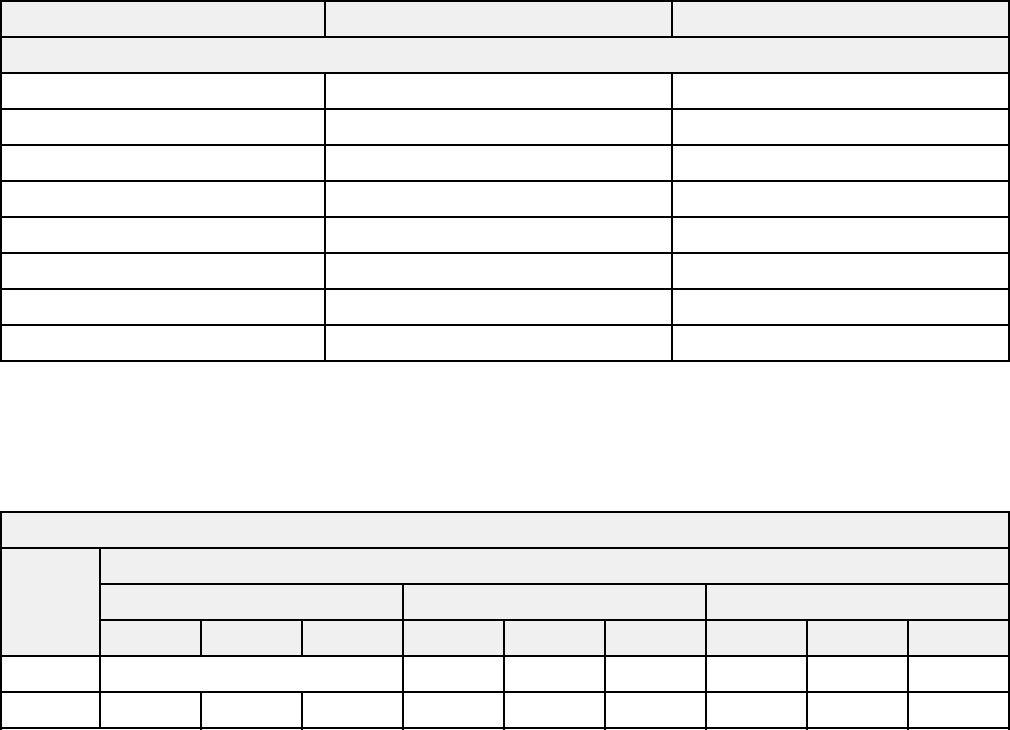
132
Supported Video Display Formats
For best results, your computer's monitor port or video card resolution should be set to display in the
projector's native resolution. However, your projector includes Epson's SizeWise chip that supports other
computer display resolutions, so your image will be resized to fit automatically.
Your computer's monitor port or video card refresh rate (vertical frequency) must be compatible with the
projector. (See your computer or video card manual for details.)
The table here lists the compatible refresh rate and resolution for each compatible video display format.
Display format Refresh rate (in Hz) Resolution (in pixels)
HDMI Input Signals
VGA 59.94 640 × 480
SDTV (480p) 59.94 720 × 480
SDTV (576p) 50 720 × 576
HDTV (720p) 50/59.94/60 1280 × 720
HDTV (1080i) 50/59.94/60 1920 × 1080
HDTV (1080p) 23.98/24/29.97/30/50/59.94/60 1920 × 1080
4K Enhancement 23.98/24/25/29.97/30/50/59.94/60 3840 × 2160
4K 23.98/24/50/59.94/60 4096 × 2160
Note: For screen sizes above 300″, a high-gain screen and a light-controlled environment may be
required.
See the table below for HDR support information for your projector.
Resolution: 4K Enhancement
Refresh
rate (in
Hz)
YCbCr
4:2:0 4:2:2 4:4:4
8 10 12 8 10 12 8 10 12
30 Signal does not exist SDR HDR HDR SDR — —
60 SDR — — — — — — — —

134
Notices
Check these sections for important notices about your projector.
Recycling (U.S. and Canada)
Important Safety Information
Important Safety Instructions
Warning Labels
List of Safety Symbols and Instructions
FCC Compliance Statement
Binding Arbitration and Class Waiver
Trademarks
Copyright Notice
Recycling (U.S. and Canada)
Epson offers a recycling program for end of life products. Please go to this site for information on how to
return your products for proper disposal.
Parent topic: Notices
Important Safety Information
Caution: Never look into the projector lens when the light source is on. This can damage your eyes and
is especially dangerous for children. Before cleaning any part of the projector, turn it off and unplug the
power cord. Never open any cover on the projector, except as specifically explained in this manual.
Dangerous electrical voltages in the projector can injure you severely. Except as specifically explained in
this User's Guide , do not attempt to service this product yourself. Refer all servicing to qualified service
personnel.
Warning: The projector and its accessories come packaged in plastic bags. Keep plastic bags away
from small children to avoid any risk of suffocation.
Caution: When you replace the lamp, never touch the new lamp with your bare hands; the invisible
residue left by the oil on your hands may shorten the lamp life. Use a cloth or glove to handle the new
lamp.
Parent topic: Notices
135
Important Safety Instructions
Follow these safety instructions when setting up and using the projector:
• Do not look into the lens when the projector is on. The bright light can damage your eyes. Avoid
standing in front of the projector so you do not block the projected image and the bright light does not
shine into your eyes. Be especially careful if children are around. Do not look into the lens using
optical devices such as loupes or telescopes.
• Do not install or place the projector vertically. Doing so may cause a malfunction.
• When turning on the projector at a distance using the remote control, make sure there is no one
looking into the lens.
• Do not touch the lens with bare hands. You may not be able to project clearly if the surface of the lens
is smeared with fingerprints or oil.
• Do not place the projector on an unstable cart, stand, or table or on a surface that is unable to support
its weight. Otherwise, it could fall or topple causing damage, deformation or an accident and injury.
• Do not operate the projector on its side, or while tilted to one side. Do not tilt the projector more than
10° forward or back.
• Installing the projector on the ceiling or on a wall requires specialist knowledge. If installation work is
not carried out correctly, the projector could fall down. This may result in injury or accidents. Contact
your dealer to carry out the installation work.
• Failure to install the ceiling mount and projector correctly may cause the projector to fall. After
installing the specific Epson mount that supports your projector, make sure you secure the mount to all
of the projector's ceiling mount fixing points. Also, secure the projector and the mounts using wire that
is strong enough to hold their weight.
• When installing the projector in a high position, take measures to prevent it from falling by using wires
to ensure safety in an emergency, such as an earthquake, and to prevent accidents. If the projector is
not installed correctly, the projector could fall. This may result in injury or accidents.
• Do not install in locations where salt damage could occur, or in locations subject to corrosive gas such
as sulphuric gas from hot springs. Otherwise, corrosion could cause the projector to fall. It could also
cause the projector to malfunction.
• When installing or adjusting a ceiling or wall mount, do not use adhesives to prevent the screws from
loosening and do not use oils or lubricants. This may cause the projector case to crack and the
projector to fall from its ceiling mount. This could cause serious injury to anyone under the mount and
could damage the projector.
136
• Do not install the projector in locations exposed to high humidity and dust, such as on a kitchen
counter, in the kitchen, or near a humidifier, or in locations exposed to oil smoke or steam. Doing so
could cause fire or electric shock.
• Do not use the projector near water, sources of heat, high-voltage electrical wires, or sources of
magnetic fields. These may interfere with correct operation.
• Do not use a power source with a voltage other than those specified in this manual.
• Use the type of power source indicated on the projector. Use of a different power source may result in
fire or electric shock. If you are not sure of the power available, consult your dealer or power company.
• Place the projector near a wall outlet where the plug can be easily unplugged.
• Take the following precautions when handling the plug: Do not hold the plug with wet hands. Do not
insert the plug into a dusty outlet. Insert the plug firmly into the outlet. Do not pull the power cord when
disconnecting the plug; always be sure to hold the plug when disconnecting it. Do not overload wall
outlets, extension cords, or power strips. Do not modify the plug. Failure to comply with these
precautions could result in fire or electric shock.
• Do not place the projector where the cord can be walked on. This may result in fraying or damage to
the plug.
• Unplug the projector from the wall outlet and allow to cool before cleaning. This avoids electric shock
during cleaning. Use a dry cloth (or, for stubborn dirt or stains, a moist cloth that has been wrung dry)
for cleaning. Do not use liquid or aerosol cleaners, any sprays containing flammable gas, or solvents
such as alcohol, paint thinner, or benzine. Water infiltration or deterioration and breakage of the
projector housing could result in electric shock.
• Do not block the slots and openings in the projector case. They provide ventilation and prevent the
projector from overheating. Do not operate the projector on a sofa, rug, or other soft surface, or set it
on top of loose papers. Do not cover the projector with a blanket, curtain, or tablecloth. If you are
setting up the projector near a wall, leave at least 7.9 inches (20 cm) of space between the wall and
the projector. On the side where hot air is exhausted from the projector, leave at least 11.8 inches (30
cm) of space between the wall and the projector.
• Do not operate the projector in a closed-in cabinet or airtight location unless proper ventilation is
provided. If the location is not sufficiently ventilated, hot exhaust from the projector will accumulate
and could trigger the projector's built-in protection circuits, and the projector may malfunction.
• Never allow objects of any kind to enter any openings in the projector. Do not leave objects, especially
flammable objects, near the projector. Do not place any containers of liquid or chemicals on top of the
unit. Never spill liquid of any kind into the projector. Fire or electric shock may result.
• Do not insert or drop metal, flammable, or foreign objects into the projector's vents or openings nor
leave them nearby. Doing so may result in fire, electric shock, or burns.
137
• You may need to clean the air filter and vent. A clogged air filter or vent can block ventilation needed
to cool the projector. Do not use canned air, or the gases may leave a residue.
• Do not use or store the projector in locations where it will be subject to dust or dirt. Otherwise, the
quality of the projected image may decline, or the air filter may become clogged, resulting in a
malfunction or fire.
• Do not store the projector outdoors for an extended length of time.
• Except as specifically explained in this manual, do not attempt to service this product yourself. Refer
all servicing to qualified personnel. Opening or removing covers may expose you to dangerous
voltages and other hazards.
• Never open any covers on the projector except as specifically explained in this manual. Never attempt
to disassemble or modify the projector (including consumables). Refer all repairs to qualified service
personnel. Electrical voltages inside the projector can cause fire, electrical shock, or serious injury to
occur.
• Unplug the projector from the wall outlet and refer servicing to qualified service personnel under the
following conditions: if it does not operate normally when you follow the operating instructions, or
exhibits a distinct change in performance; if smoke, strange odors, or strange noises come from the
projector; if the power cord or plug is damaged or frayed; if liquid or foreign objects get inside the
projector, or if it has been exposed to rain or water; if it has been dropped or the housing has been
damaged. Continuing to use the projector under these conditions may result in fire, electric shock, or
even damage to your eyesight. Do not try to repair this projector yourself. Place the projector near an
easily accessible outlet so that the plug can be unplugged immediately when an error occurs.
• Do not touch the plug during an electrical storm. Otherwise, you may receive an electric shock.
• Unplug the projector when it will not be used for extended periods. The insulation may deteriorate,
which may result in fire.
• Do not use the projector where it may be exposed to rain, water, or excessive humidity. Fire or electric
shock may result.
• Do not use or store the projector where it may be exposed to smoke, steam, corrosive gases,
excessive dust, vibration, or shock.
• Do not use the projector in places where chlorine and mineral components contained in tap water may
be atomized, particularly near ultrasonic humidifiers; otherwise, malfunctions may result or the quality
of the projected image may decline.
• Do not use or store the projector in places where smoke from oil or cigarettes may be present, as it
can adversely affect the quality of the projected images.
• Do not use the projector where flammable or explosive gases may be present.
138
• Do not use sprays containing a flammable gas to remove dirt or dust from parts such as the lens or the
air filter. The inside of the projector can get very hot during use and the gases may ignite, resulting in a
fire. Use a vacuum or hand-operated air blower to remove dirt or dust that has adhered to parts such
as the lens or the air filter.
• Do not use or store the projector or remote control with its batteries in a hot location, such as near a
heater, in direct sunlight, or in a closed vehicle. Thermal deformation or technical malfunction may
occur, which may result in a fire.
• Check the specifications for the power cable. Using an inappropriate power cable could result in fire or
electric shock. The power cable supplied with the projector is intended to comply with power supply
requirements for the country of purchase. If you use the projector in the country where it was
purchased, only use the power cable that came with the projector.
• If you use the projector in a country other than where you purchased it, use the correct power cord for
that country.
• Do not stand on the projector or place heavy objects on it. You may fall over, resulting in injury and
damage to the projector.
• If you are using the projector at altitudes above 4,921 feet (1,500 m), enable the High Altitude Mode
setting in the projector's menu to ensure the projector's internal temperature is regulated properly.
• Do not use the projector outside of the required temperature range below (20 to 80% humidity, no
condensation):
41 to 95 °F (5 to 35 °C) at an altitude of 7500 feet (2286 m) or less, or 41 to 86 °F (5 to 30 °C) at an
altitude of 7500 to 10000 feet (2286 m to 3048 m)
Doing so may cause an unstable display and could lead to projector damage. Do not use or store the
projector where it may be exposed to sudden changes in temperature.
• Do not use or store the projector in places where it might be subjected to high and low extremes of
temperature.
• Do not store the projector outside of the required temperature range of 14 to 140 °F (–10 to 60 °C) or
in direct sunlight for long periods of time. Doing so may cause damage to the case.
• Do not place anything that can become warped or damaged by heat near the exhaust vents. Do not
bring your hands or face close to the vents while projection is in progress. Do not bring your face close
to the projector while it is in use. Hot air from the exhaust vents could cause burns, warping, or other
damage to property.
• Before you move the projector, make sure its power is turned off, the plug is disconnected from the
outlet, and all cables are disconnected. Fire or electric shock may result.
• Never try to remove the lamp immediately after use because it will be extremely hot. Before removing
the lamp, turn off the power and wait at least an hour to allow the lamp to cool completely.
139
• Do not disassemble the lamp or subject it to impacts.
• Do not place the source of an open flame, such as a lit candle, on or near the projector.
• During projection, do not block the light from the projector with a book or other objects. If the light from
the projector is blocked, the area on which the light shines becomes hot which could cause it to melt,
burn, or start a fire. Also, the lens may get hot due to the reflected light which could cause the
projector to malfunction. To stop projection, use the A/V Mute function, or turn off the projector.
• Do not modify the power cord. Do not place heavy objects on top of the power cord or bend, twist, or
pull it excessively. Keep the power cord away from hot electrical appliances. Do not tie the power cord
to other cables. Do not use the power cord if it is damaged. Fire or electric shock may result. Contact
your dealer if the cable becomes damaged.
• If the lamp breaks, ventilate the area immediately, and contact a doctor if any fragments of broken
glass are inhaled or get into the eyes or mouth
• Always lower the volume before turning off the projector. Turning on the projector with the volume too
high can damage your ears. Gradually increase the volume after turning on the projector.
• When a still image is displayed for a long time, image retention may occur on the screen. Do not
display images in the exact same position for long periods.
• Always attach the lens cover to the lens when not using the projector to prevent the lens from
becoming dirty or damaged.
• Incorrect battery usage may cause leakage of battery fluid and battery rupture, which could result in
fire, injury, or corrosion. When replacing batteries, take the following precautions: insert batteries so
that the polarities (+ and -) are correct; do not use batteries of different types or mix old and new
batteries; do not use any batteries other than those specified in this manual; if batteries leak, wipe
away battery fluid with a soft cloth and replace them with new batteries; if battery fluid gets on your
hands, wash them immediately; replace the batteries as soon as they run out; remove the batteries if
you will not be using the projector for a long period of time; do not expose batteries to heat or flame
and do not put them in water; dispose of used batteries according to local regulations; keep batteries
out of the reach of children. Batteries are choking hazards and are very dangerous if swallowed. If a
battery is swallowed, seek medical attention immediately.
• Remove the batteries from the remote control before storing the projector. If the batteries are left in the
remote control for long periods, they may leak.
• Do not disassemble the projector when disposing of it. Dispose of the projector according to your local
or national laws and regulations.
• Do not beam any lasers into the projector. If a high-powered laser is beamed through the surface of
the projection lens, it can cause a malfunction. Use non-permeable and incombustible metal plates,
such as aluminum or iron, to block lasers and protect the projection lens, if needed.
140
• A mercury lamp with high internal pressure is used as the projector's light source. If the lamp is
subjected to vibrations or shocks, or if it is used for an overly extended length of time, the lamp may
break or it may not turn on. If the lamp explodes, gases may escape and small fragments of glass may
be scattered which could cause an injury.
Restriction of Use
Parent topic: Notices
Restriction of Use
When this product is used for applications requiring high reliability/safety such as transportation devices
related to aviation, rail, marine, automotive; disaster prevention devices; various safety devices; or
functional/precision devices, you should use this product only after giving consideration to including fail-
safes and redundancies into your design to maintain safety and total system reliability.
Because this product was not intended for use in applications requiring extremely high reliability/safety
such as aerospace equipment, main communication equipment, nuclear power control equipment, or
medical equipment related to direct medical care, please make your own judgment on this product's
suitability after a full evaluation.
Parent topic: Important Safety Instructions
Warning Labels
This product comes with a warning label.
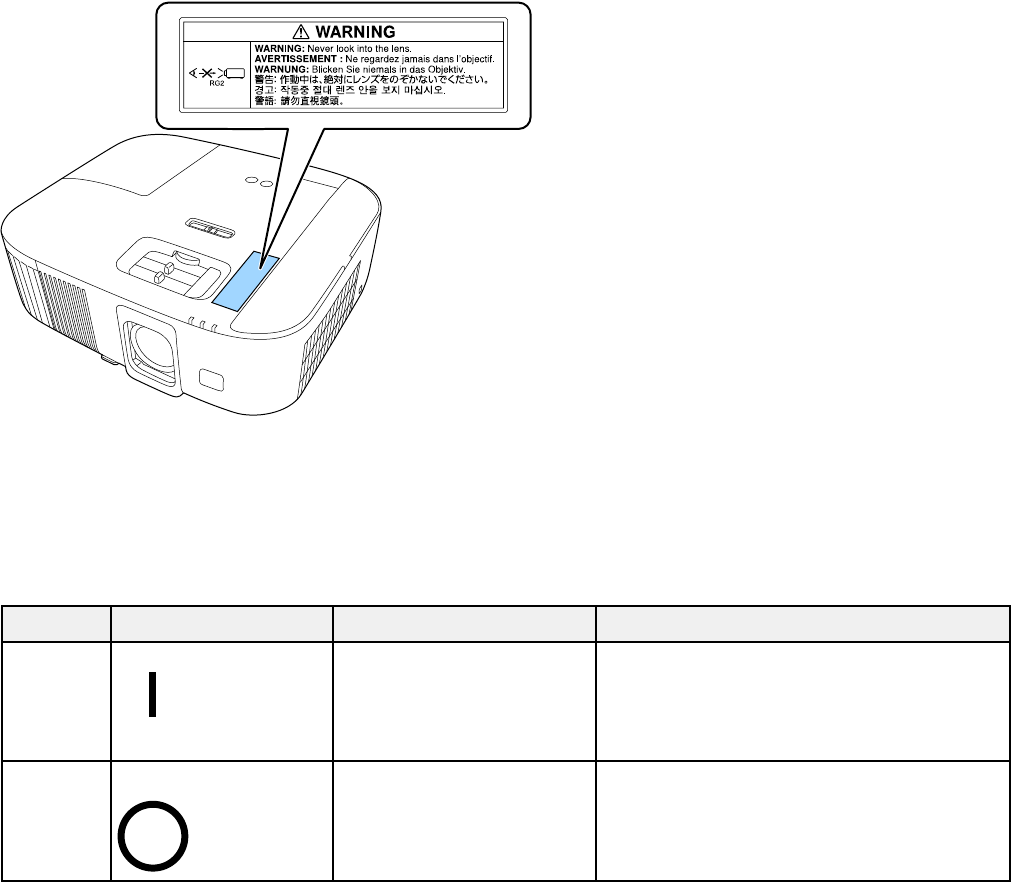
141
As with any bright source, do not stare into the beam (RG2 IEC/EN 62471-5:2015).
Parent topic: Notices
List of Safety Symbols and Instructions
The following table lists the meaning of the safety symbols labeled on the equipment.
No. Symbol Approved Standards Description
1 IEC60417
No.5007
"ON" (power)
To indicate connection to the mains.
2 IEC60417
No. 5008
"OFF" (power)
To indicate disconnection from the
mains.

142
No. Symbol Approved Standards Description
3 IEC60417
No. 5009
Standby
To identify the switch or switch position
by means of which part of the equipment
is switched on in order to bring it into the
standby condition.
4 ISO7000
No. 0434B
IEC3864-B3.1
Caution
To identify general caution when using
the product.
5 IEC60417
No. 5041
Caution, hot surface
To indicate that the marked item can be
hot and should not be touched without
taking care.
6 IEC60417
No. 6042
ISO3864-B3.6
Caution, risk of electric shock
To identify equipment that has risk of
electric shock.
7 IEC60417
No. 5957
For indoor use only
To identify electrical equipment designed
primarily for indoor use.
8 IEC60417
No. 5926
Polarity of DC power connector
To identify the positive and negative
connections (the polarity) on a piece of
equipment to which a DC power supply
may be connected.
9 — Polarity of DC power connector
To identify the positive and negative
connections (the polarity) on a piece of
equipment to which a DC power supply
may be connected.

143
No. Symbol Approved Standards Description
10 IEC60417
No. 5001B
Battery, general
On battery powered equipment. To
identify a device for instance a cover for
the battery compartment, or the
connector terminals.
11 IEC60417
No. 5002
Positioning of cell
To identify the battery holder itself and to
identify the positioning of the cell(s)
inside the battery holder.
12 — Positioning of cell
To identify the battery holder itself and to
identify the positioning of the cell(s)
inside the battery holder.
13 IEC60417
No. 5019
Protective earth
To identify any terminal which is intended
for connection to an external conductor
for protection against electric shock in
case of a fault, or the terminal of a
protective earth electrode.
14 IEC60417
No. 5017
Earth
To identify an earth (ground) terminal in
cases where neither the symbol No.13 is
explicitly required.
15 IEC60417
No. 5032
Alternating current
To indicate on the rating plate that the
equipment is suitable for alternating
current only; to identify relevant
terminals.
16 IEC60417
No. 5031
Direct current
To indicate on the rating plate that the
equipment is suitable for direct current
only; to identify relevant terminals.
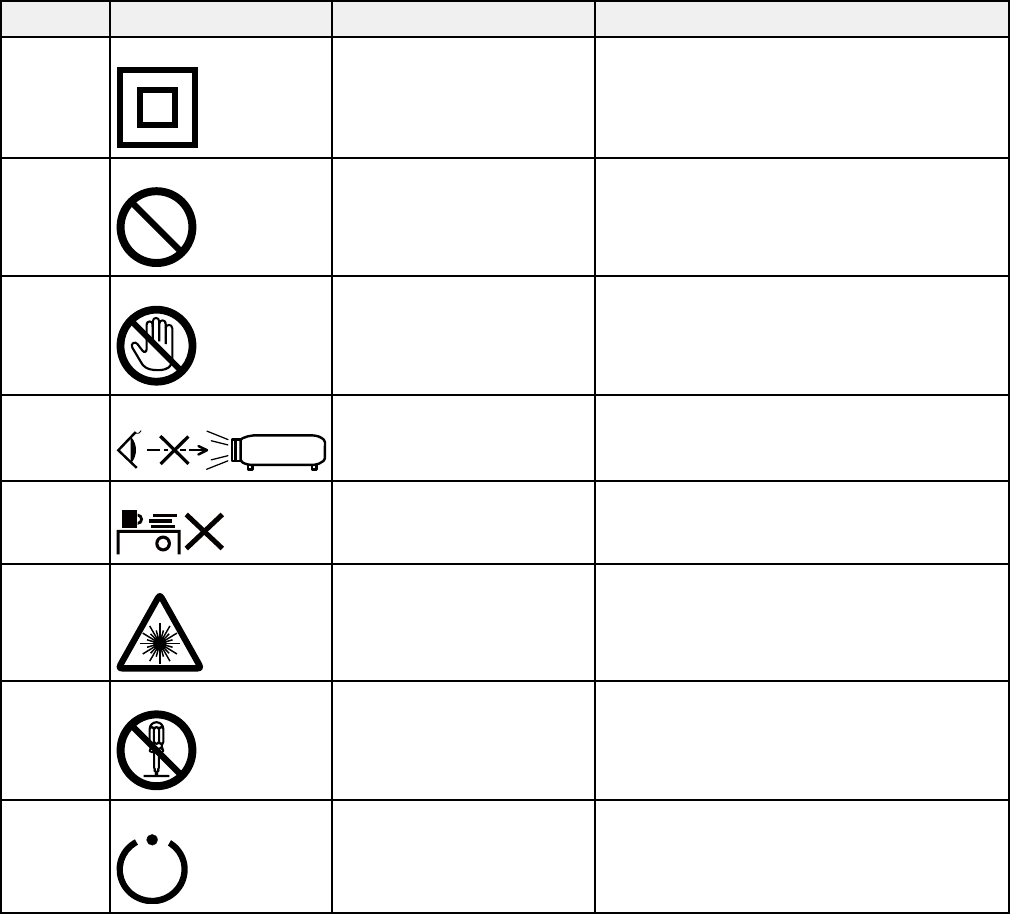
144
No. Symbol Approved Standards Description
17 IEC60417
No. 5172
Class II equipment
To identify equipment meeting the safety
requirements specified for Class II
equipment according to IEC 61140.
18 ISO 3864 General prohibition
To identify actions or operations that are
prohibited.
19 ISO 3864 Contact prohibition
To indicate injury that could occur due to
touching a specific part of the equipment.
20 — Never look into the lens while the
projector is on.
21 — To indicate that the marked item don’ t
place anything on projector.
22 ISO3864
IEC60825-1
Caution, laser radiation
To indicate the equipment has a laser
radiation part.
23 ISO 3864 Disassembly prohibition
To indicate a risk of injury, such as
electric shock, if the equipment is
disassembled.
24 IEC60417
No. 5266
Standby, partial standby
To indicate that part of the equipment is
in the ready status.
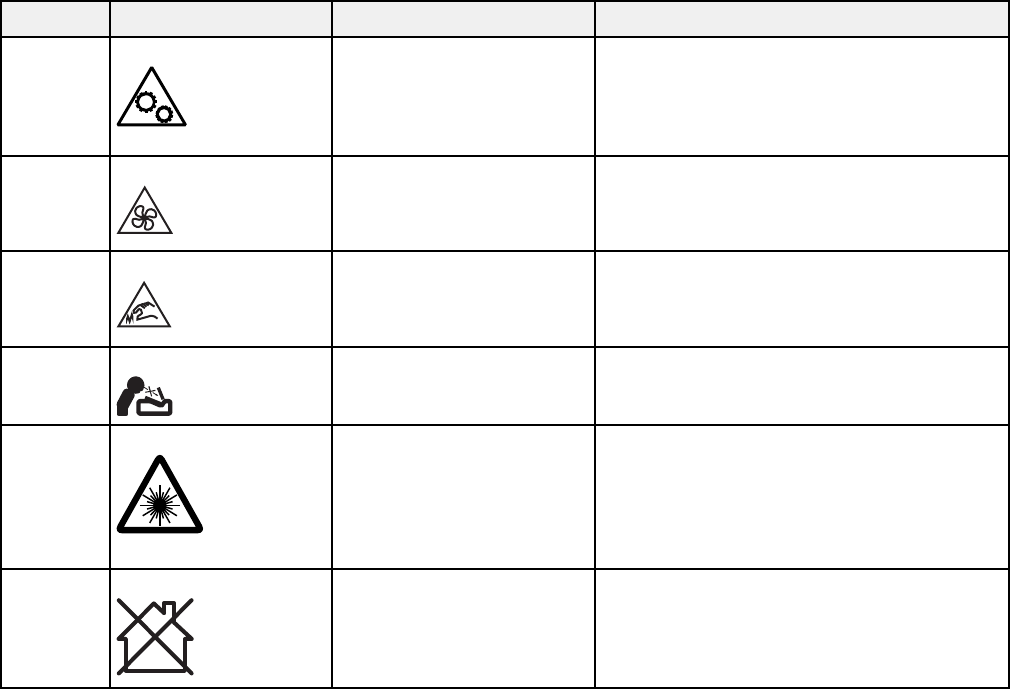
145
No. Symbol Approved Standards Description
25 ISO3864
IEC60417
No. 5057
Caution, movable parts
To indicate that you must keep away
from movable parts according to
protection standards.
26 IEC60417-6056 Caution, moving fan blades
To indicate that you must keep away
from moving fan blades.
27 IEC60417-6043 Caution, sharp corners
To indicate that you must not touch sharp
corners.
28 — To indicate that looking into the lens
while projecting is prohibited.
29 ISO7010
No. W027
ISO3864
Warning, light emission (UV, visible light,
IR, etc.)
To indicate that you must be careful not
to injure your eyes or skin when near
light-emitting sections.
30 IEC60417
No. 5109
Not to be used in residential areas
To indicate that the electrical
equipment/device is not suitable for use
in a residential area.
Parent topic: Notices
FCC Compliance Statement
For United States Users
This device complies with part 15 of the FCC Rules. Operation is subject to the following two conditions:
(1) This device may not cause harmful interference, and (2) this device must accept any interference
received, including interference that may cause undesired operation.
This equipment has been tested and found to comply with the limits for a Class B digital device, pursuant
to Part 15 of the FCC Rules. These limits are designed to provide reasonable protection against harmful
146
interference in a residential installation. This equipment generates, uses, and can radiate radio
frequency energy and, if not installed and used in accordance with the instructions, may cause harmful
interference to radio communications. However, there is no guarantee that interference will not occur in
a particular installation. If this equipment does cause interference to radio and television reception, which
can be determined by turning the equipment off and on, the user is encouraged to try to correct the
interference by one or more of the following measures:
• Reorient or relocate the receiving antenna.
• Increase the separation between the equipment and receiver.
• Connect the equipment into an outlet on a circuit different from that to which the receiver is connected.
• Consult the dealer or an experienced radio/TV technician for help.
WARNING
The connection of a non-shielded equipment interface cable to this equipment will invalidate the FCC
Certification or Declaration of this device and may cause interference levels which exceed the limits
established by the FCC for this equipment. It is the responsibility of the user to obtain and use a shielded
equipment interface cable with this device. If this equipment has more than one interface connector, do
not leave cables connected to unused interfaces. Changes or modifications not expressly approved by
the manufacturer could void the user’s authority to operate the equipment.
For Canadian Users
CAN ICES-003(B)/NMB-003(B)
Parent topic: Notices
Binding Arbitration and Class Waiver
1. DISPUTES, BINDING INDIVIDUAL ARBITRATION, AND WAIVER OF CLASS ACTIONS AND
CLASS ARBITRATIONS
1.1 Disputes. The terms of this Section 1 shall apply to all Disputes between you and Epson. The term
"Dispute" is meant to have the broadest meaning permissible under law and includes any dispute, claim,
controversy or action between you and Epson arising out of or relating to this Agreement, Epson
branded products (hardware and including any related software), or other transaction involving you and
Epson, whether in contract, warranty, misrepresentation, fraud, tort, intentional tort, statute, regulation,
ordinance, or any other legal or equitable basis. "DISPUTE" DOES NOT INCLUDE IP CLAIMS, or more
specifically, a claim or cause of action for (a) trademark infringement or dilution, (b) patent infringement,
(c) copyright infringement or misuse, or (d) trade secret misappropriation (an "IP Claim"). You and Epson
also agree, notwithstanding Section 1.6,that a court, not an arbitrator, may decide if a claim or cause of
action is for an IP Claim.
147
1.2 Binding Arbitration. You and Epson agree that all Disputes shall be resolved by binding arbitration
according to this Agreement. ARBITRATION MEANS THAT YOU WAIVE YOUR RIGHT TO A JUDGE
OR JURY IN A COURT PROCEEDING AND YOUR GROUNDS FOR APPEAL ARE LIMITED.
Pursuant to this Agreement, binding arbitration shall be administered by JAMS, a nationally recognized
arbitration authority, pursuant to its code of procedures then in effect for consumer related disputes, but
excluding any rules that permit joinder or class actions in arbitration (for more detail on procedure, see
Section 1.6 below). You and Epson understand and agree that (a) the Federal Arbitration Act (9 U.S.C.
§1, et seq.) governs the interpretation and enforcement of this Section 1, (b) this Agreement
memorializes a transaction in interstate commerce, and (c) this Section 1 shall survive termination of this
Agreement.
1.3 Pre-Arbitration Steps and Notice. Before submitting a claim for arbitration, you and Epson agree to
try, for sixty (60) days, to resolve any Dispute informally. If Epson and you do not reach an agreement to
resolve the Dispute within the sixty (60) days), you or Epson may commence an arbitration. Notice to
Epson must be addressed to: Epson America, Inc., ATTN: Legal Department, 3131 Katella Ave., Los
Alamitos, CA 90720 (the "Epson Address"). The Dispute Notice to you will be sent to the most recent
address Epson has in its records for you. For this reason, it is important to notify us if your address
the Dispute shall include the sender's name, address and contact information, the facts giving rise to the
Dispute, and the relief requested (the "Dispute Notice"). Following receipt of the Dispute Notice, Epson
and you agree to act in good faith to resolve the Dispute before commencing arbitration.
1.4 Small Claims Court. Notwithstanding the foregoing, you may bring an individual action in the small
claims court of your state or municipality if the action is within that court's jurisdiction and is pending only
in that court.
1.5 WAIVER OF CLASS ACTIONS AND CLASS ARBITRATIONS. YOU AND EPSON AGREE THAT
EACH PARTY MAY BRING DISPUTES AGAINST THE OTHER PARTY ONLY IN AN INDIVIDUAL
CAPACITY, AND NOT AS A PLAINTIFF OR CLASS MEMBER IN ANY CLASS OR
REPRESENTATIVE PROCEEDING, INCLUDING WITHOUT LIMITATION FEDERAL OR STATE
CLASS ACTIONS, OR CLASS ARBITRATIONS. CLASS ACTION LAWSUITS, CLASS-WIDE
ARBITRATIONS, PRIVATE ATTORNEY-GENERAL ACTIONS, AND ANY OTHER PROCEEDING
WHERE SOMEONE ACTS IN A REPRESENTATIVE CAPACITY ARE NOT ALLOWED.
ACCORDINGLY, UNDER THE ARBITRATION PROCEDURES OUTLINED IN THIS SECTION, AN
ARBITRATOR SHALL NOT COMBINE OR CONSOLIDATE MORE THAN ONE PARTY'S CLAIMS
WITHOUT THE WRITTEN CONSENT OF ALL AFFECTED PARTIES TO AN ARBITRATION
PROCEEDING.
1.6 Arbitration Procedure. If you or Epson commences arbitration, the arbitration shall be governed by
the rules of JAMS that are in effect when the arbitration is filed, excluding any rules that permit arbitration
on a class or representative basis (the "JAMS Rules"), available at http://www.jamsadr.com or by calling
1-800-352-5267 (U.S. or Canada), or https://www.jamsadr.com/about/ or by calling +1-949-224-1810
(Latin America), and under the rules set forth in this Agreement. All Disputes shall be resolved by a
148
single neutral arbitrator, and both parties shall have a reasonable opportunity to participate in the
selection of the arbitrator. The arbitrator is bound by the terms of this Agreement. The arbitrator, and not
any federal, state or local court or agency, shall have exclusive authority to resolve all disputes arising
out of or relating to the interpretation, applicability, enforceability or formation of this Agreement,
including any claim that all or any part of this Agreement is void or voidable. Notwithstanding this broad
delegation of authority to the arbitrator, a court may determine the limited question of whether a claim or
cause of action is for an IP Claim, which is excluded from the definition of "Disputes" in Section 1.1
above. The arbitrator shall be empowered to grant whatever relief would be available in a court under
law or in equity. The arbitrator may award you the same damages as a court could, and may award
declaratory or injunctive relief only in favor of the individual party seeking relief and only to the extent
necessary to provide relief warranted by that party's individual claim. In some instances, the costs of
arbitration can exceed the costs of litigation and the right to discovery may be more limited in arbitration
than in court. The arbitrator's award is binding and may be entered as a judgment in any court of
competent jurisdiction.
You may choose to engage in arbitration hearings by telephone. Arbitration hearings not conducted by
telephone shall take place in a location reasonably accessible from your primary residence, or in Orange
County, California, at your option.
a) Initiation of Arbitration Proceeding. If either you or Epson decides to arbitrate a Dispute, both parties
agree to the following procedure:
(i) Write a Demand for Arbitration. The demand must include a description of the Dispute and the amount
of damages sought to be recovered. You can find a copy of a Demand for Arbitration at
http://www.jamsadr.com ("Demand for Arbitration").
(ii) Send three copies of the Demand for Arbitration, plus the appropriate filing fee, to: JAMS, 500 North
State College Blvd., Suite 600 Orange, CA 92868, U.S.A.
(iii) Send one copy of the Demand for Arbitration to the other party (same address as the Dispute
Notice), or as otherwise agreed by the parties.
b) Hearing Format. During the arbitration, the amount of any settlement offer made shall not be disclosed
to the arbitrator until after the arbitrator determines the amount, if any, to which you or Epson is entitled.
The discovery or exchange of non-privileged information relevant to the Dispute may be allowed during
the arbitration.
c) Arbitration Fees. Epson shall pay, or (if applicable) reimburse you for, all JAMS filings and arbitrator
fees for any arbitration commenced (by you or Epson) pursuant to provisions of this Agreement.
d) Award in Your Favor. For Disputes in which you or Epson seeks $75,000 or less in damages exclusive
of attorney's fees and costs, if the arbitrator's decision results in an award to you in an amount greater
than Epson's last written offer, if any, to settle the Dispute, Epson will: (i) pay you $1,000 or the amount
of the award, whichever is greater; (ii) pay you twice the amount of your reasonable attorney's fees, if
any; and (iii) reimburse you for any expenses (including expert witness fees and costs) that your attorney
149
reasonably accrues for investigating, preparing, and pursuing the Dispute in arbitration. Except as
agreed upon by you and Epson in writing, the arbitrator shall determine the amount of fees, costs, and
expenses to be paid by Epson pursuant to this Section 1.6d).
e) Attorney's Fees. Epson will not seek its attorney's fees and expenses for any arbitration commenced
involving a Dispute under this Agreement. Your right to attorney's fees and expenses under Section
1.6d) above does not limit your rights to attorney's fees and expenses under applicable law;
notwithstanding the foregoing, the arbitrator may not award duplicative awards of attorney's fees and
expenses.
1.7 Opt-out. You may elect to opt-out (exclude yourself) from the final, binding, individual
arbitration procedure and waiver of class and representative proceedings specified in this
Agreement by sending a written letter to the Epson Address within thirty (30) days of your assent
to this Agreement (including without limitation the purchase, download, installation of the
Software or other applicable use of Epson Hardware, products and services) that specifies (i)
your name, (ii) your mailing address, and (iii) your request to be excluded from the final, binding
individual arbitration procedure and waiver of class and representative proceedings specified in
this Section 1. In the event that you opt-out consistent with the procedure set forth above, all
other terms shall continue to apply, including the requirement to provide notice prior to litigation.
1.8 Amendments to Section 1. Notwithstanding any provision in this Agreement to the contrary, you
and Epson agree that if Epson makes any future amendments to the dispute resolution procedure and
class action waiver provisions (other than a change to Epson's address) in this Agreement, Epson will
obtain your affirmative assent to the applicable amendment. If you do not affirmatively assent to the
applicable amendment, you are agreeing that you will arbitrate any Dispute between the parties in
accordance with the language of this Section 1 (or resolve disputes as provided for in Section 1.7, if you
timely elected to opt-out when you first assented to this Agreement).
1.9 Severability. If any provision in this Section 1 is found to be unenforceable, that provision shall be
severed with the remainder of this Agreement remaining in full force and effect. The foregoing shall not
apply to the prohibition against class or representative actions as provided in Section 1.5. This
means that if Section 1.5 is found to be unenforceable, the entire Section 1 (but only Section 1)
shall be null and void.
Parent topic: Notices
Trademarks
EPSON
®
, Instant Off
®
, and Quick Corner
®
are registered trademarks and EPSON Exceed Your Vision is
a registered logomark of Seiko Epson Corporation.
PrivateLine
®
is a registered trademark and SizeWise
TM
is a trademark of Epson America, Inc.
Windows and the Windows logo are trademarks or registered trademarks of Microsoft Corporation in the
United States and/or other countries.

150
Mac is a trademark of Apple Inc., registered in the U.S. and other countries.
Google
®
, Google Assistant, Google Play, YouTube, and Android TV
TM
are trademarks of Google LLC.
Google Assistant is not available in certain languages and countries. Availability of services varies by
country and language.
Netflix is a registered trademark of Netflix, Inc.
The Bluetooth
®
word mark and logo are registered trademarks of Bluetooth SIG, Inc., and the Seiko
Epson Corporation uses these marks under license.
HDMI, the HDMI Logo, and High-Definition Multimedia Interface are trademarks or registered
trademarks of HDMI Licensing Administrator, Inc.
General Notice: Other product names used herein are for identification purposes only and may be
trademarks of their respective owners. Epson disclaims any and all rights in those marks.
Parent topic: Notices
Copyright Notice
All rights reserved. No part of this publication may be reproduced, stored in a retrieval system, or
transmitted in any form or by any means, electronic, mechanical, photocopying, recording, or otherwise,
without the prior written permission of Seiko Epson Corporation. The information contained herein is
designed only for use with this Epson product. Epson is not responsible for any use of this information as
applied to other products.
Neither Seiko Epson Corporation nor its affiliates shall be liable to the purchaser of this product or third
parties for damages, losses, costs, or expenses incurred by purchaser or third parties as a result of:
accident, misuse, or abuse of this product or unauthorized modifications, repairs, or alterations to this
product, or (excluding the U.S.) failure to strictly comply with Seiko Epson Corporation's operating and
maintenance instructions.
Seiko Epson Corporation shall not be liable for any damages or problems arising from the use of any
options or any consumable products other than those designated as Original Epson Products or Epson
Approved Products by Seiko Epson Corporation.
This information is subject to change without notice.
A Note Concerning Responsible Use of Copyrighted Materials
151
Copyright Attribution
Parent topic: Notices
A Note Concerning Responsible Use of Copyrighted Materials
Epson encourages each user to be responsible and respectful of the copyright laws when using any
Epson product. While some countries' laws permit limited copying or reuse of copyrighted material in
certain circumstances, those circumstances may not be as broad as some people assume. Contact your
legal advisor for any questions regarding copyright law.
Parent topic: Copyright Notice
Copyright Attribution
© 2022 Epson America, Inc.
10/22
CPD-62284R1
Parent topic: Copyright Notice
